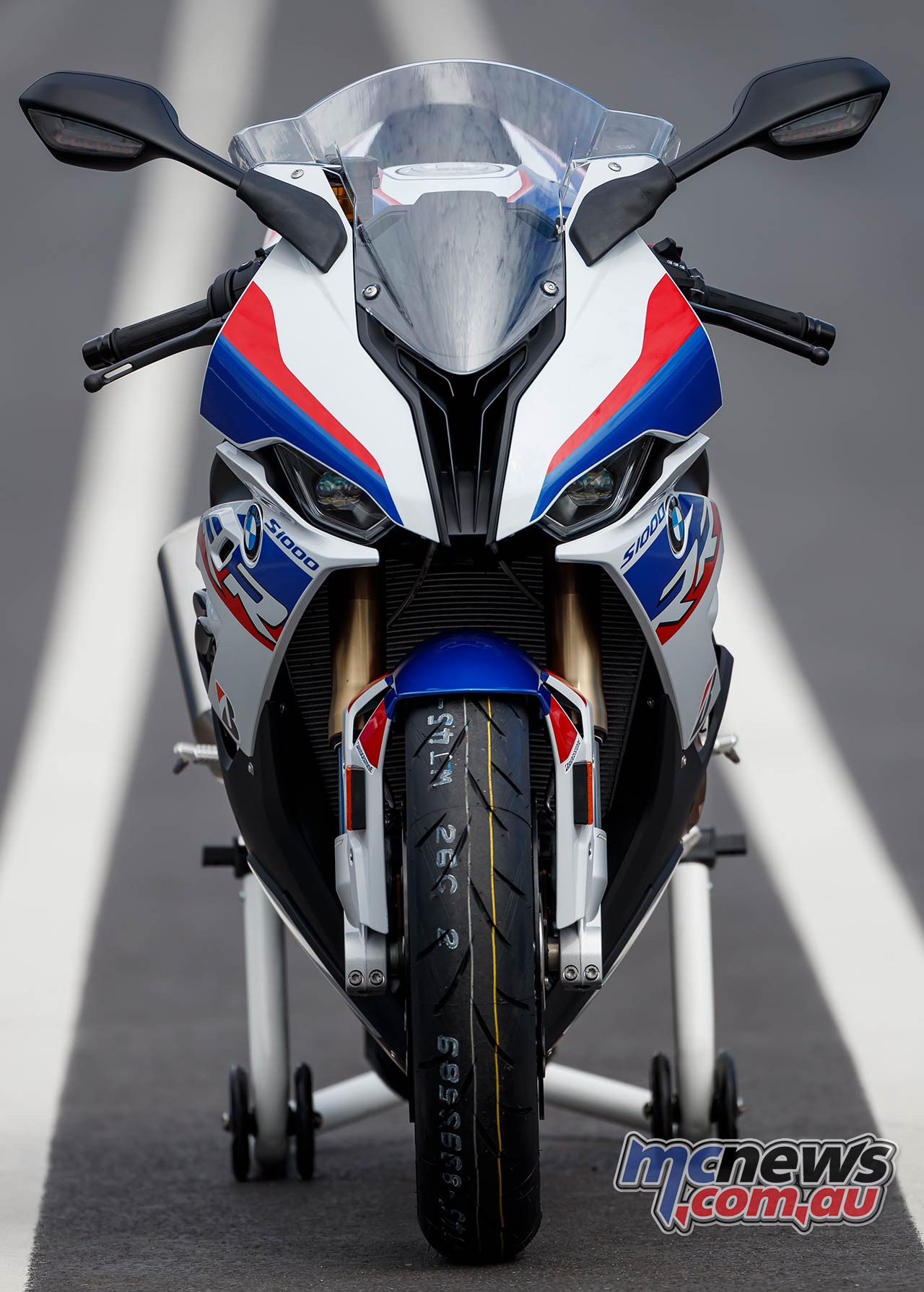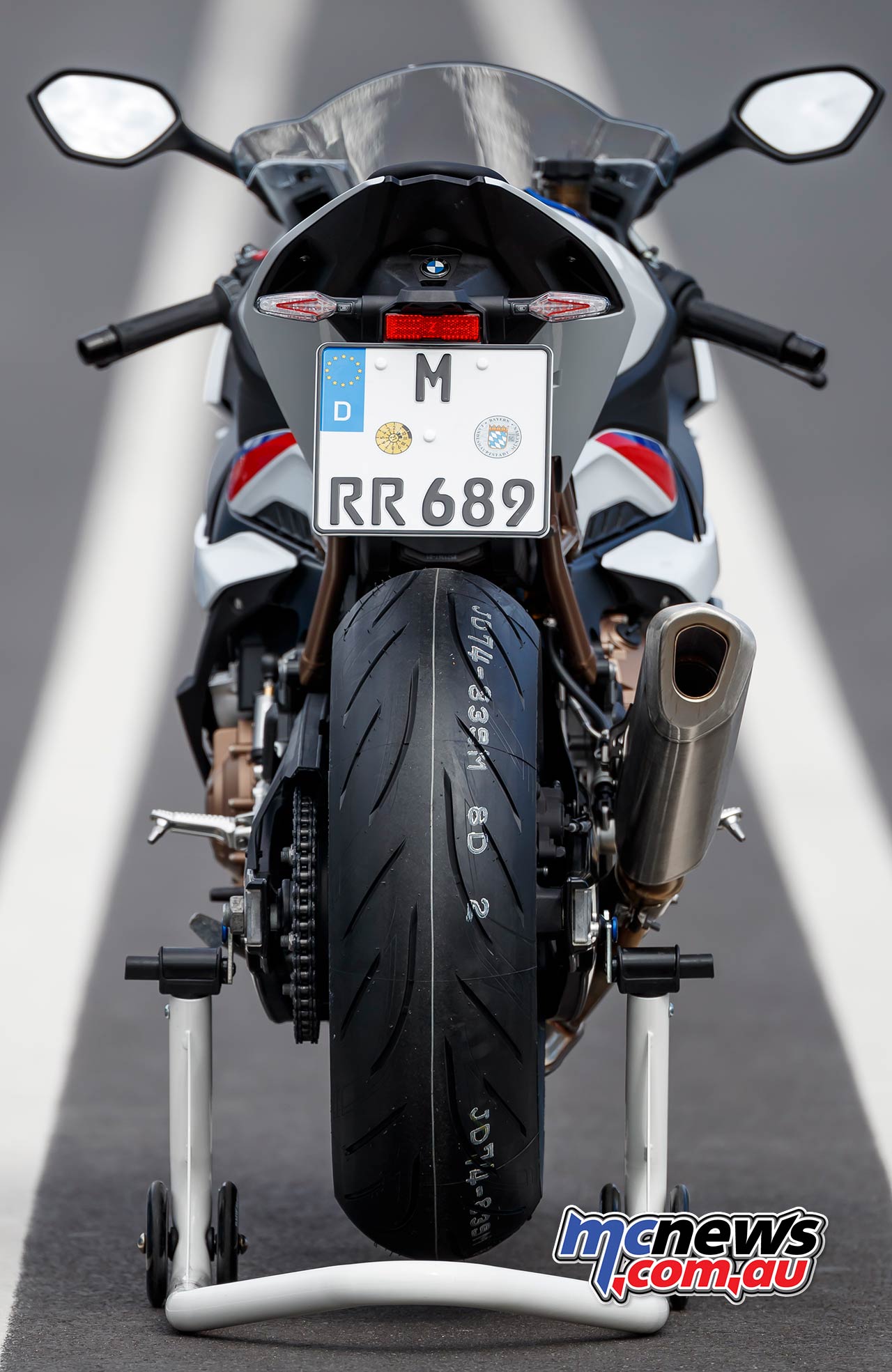2019 BMW S 1000 RR Review
Testing the ‘M Package’ at Estoril
BMW S 1000 RR Test by Steve Martin

With a bike in the stable as proficient and fast as the 2018 BMW S 1000 RR is, it’s quite a big ask to make one better. But that was the goal that BMW set themselves when they embarked on building their technologically advanced new litre sports bike.
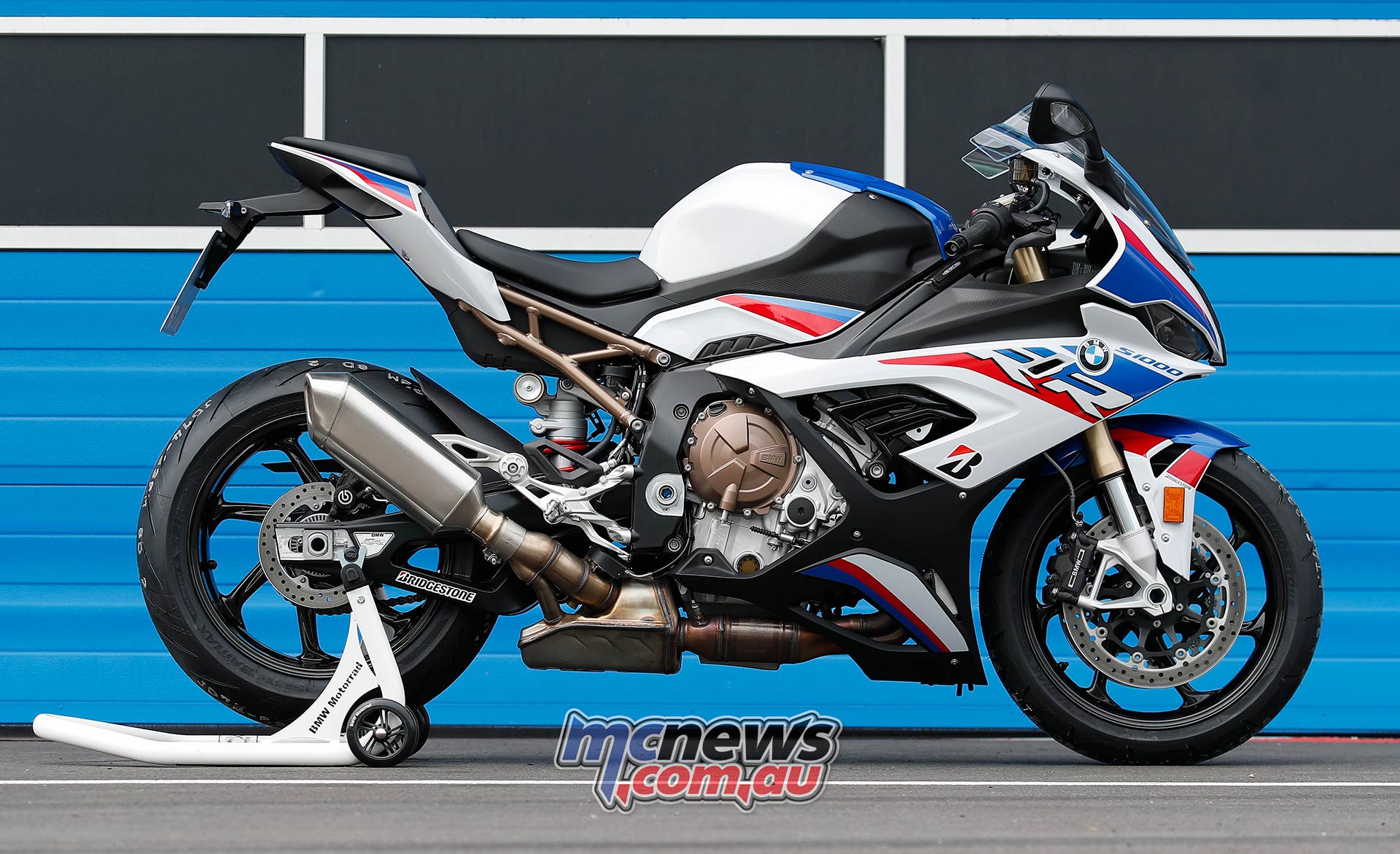
The 2019 S 1000 RR was not going to be a sticker kit and paint job, but rather the next evolution that would need to go on and take things to the next level, just like the original did back in 2010. A machine that would not only be at home on the racetrack, but a bike that was easier to handle day-to-day, by offering a smattering of sensible road orientated goodies as icing on the very fast cake.
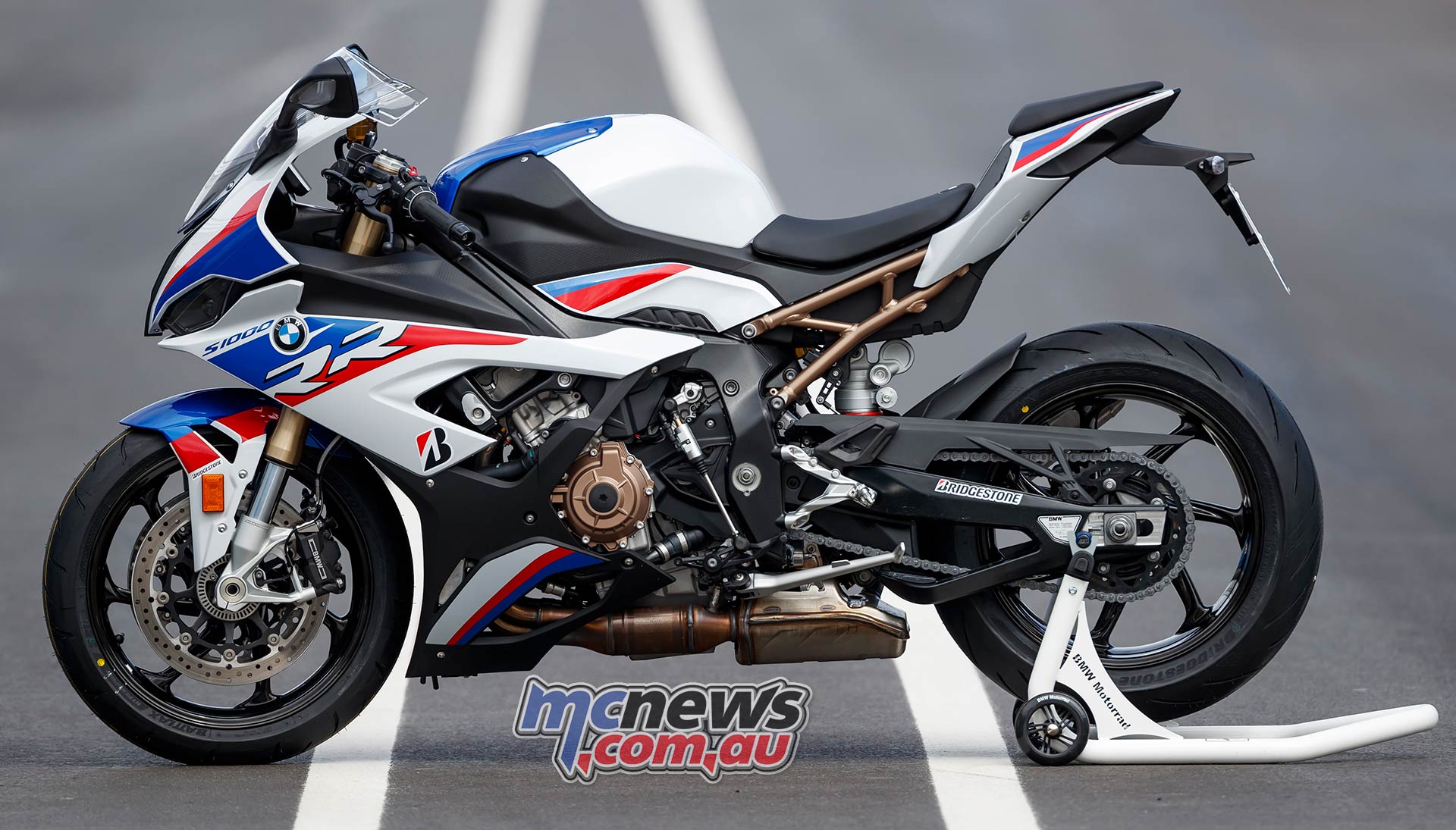
On top of all of that though, the aim was to grab back the title of king of the litre bikes, in a class that now has a couple of 1100s thrown in for good measure.
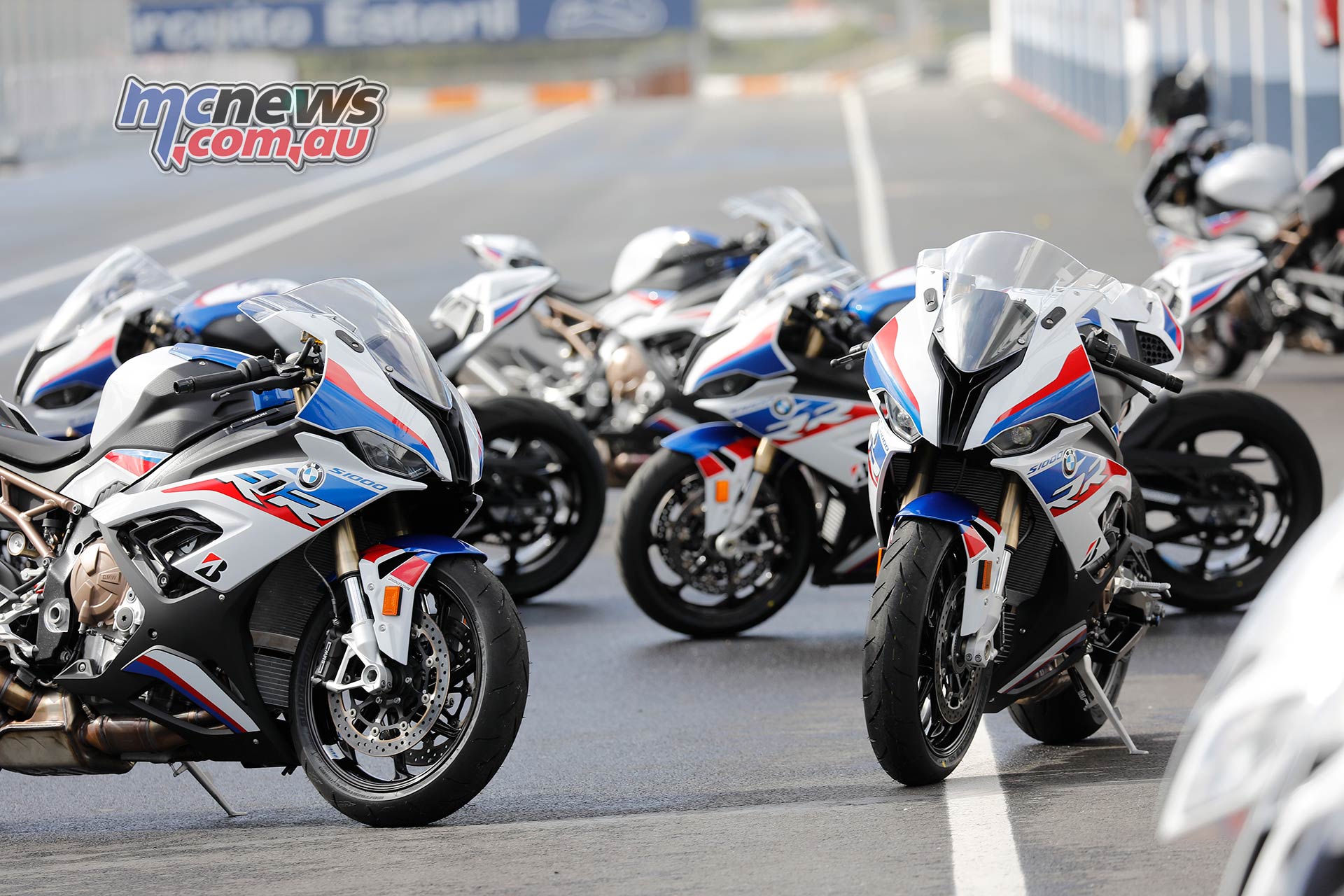
Germans like measurements and one-second is the rounded figure that they settled on. That was their measure of how much the new bike should be faster per lap, with the same tyres and same rider, on the same day. Now that would be easy to achieve if the ’18 model was a slug, but it’s not, it’s still a cutting-edge machine. So to produce a successor that took yet another leap forward, some careful thought and new technology was required.
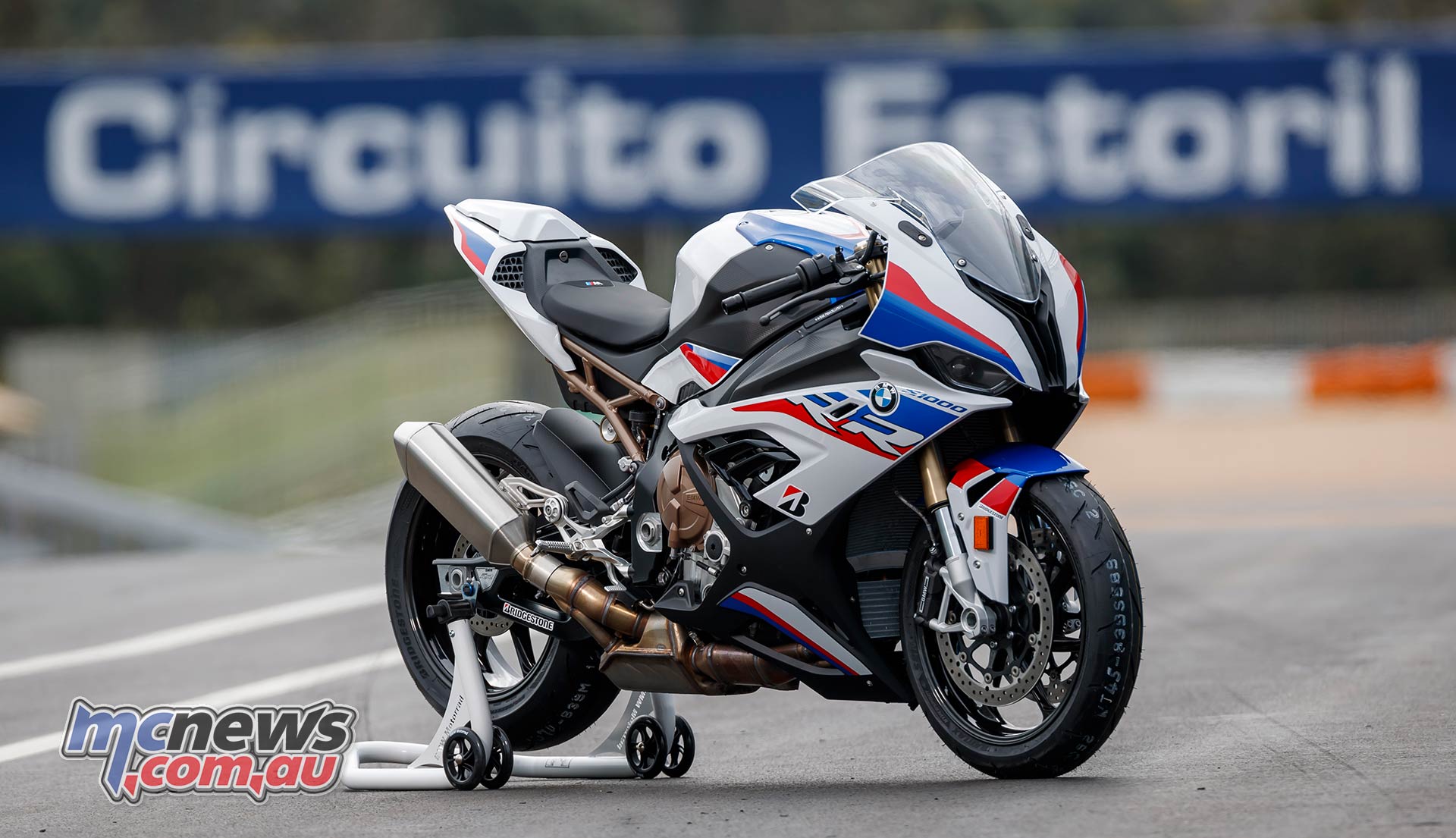
All aspects were looked at and by paring down the weight, improving the handling, and adding more power and torque, BMW have ticked all the boxes.
The 2019 model comes in two colours with the option to order them with different kits depending on your wicked desires, and budget. There’s a race kit, a dynamic kit and the ‘M Package’ which gives you the attributes of the other two, but adds in some extra special goodies like carbon wheels. On test we only had the chance to try the M kitted bike but, in all honesty, I wasn’t complaining.
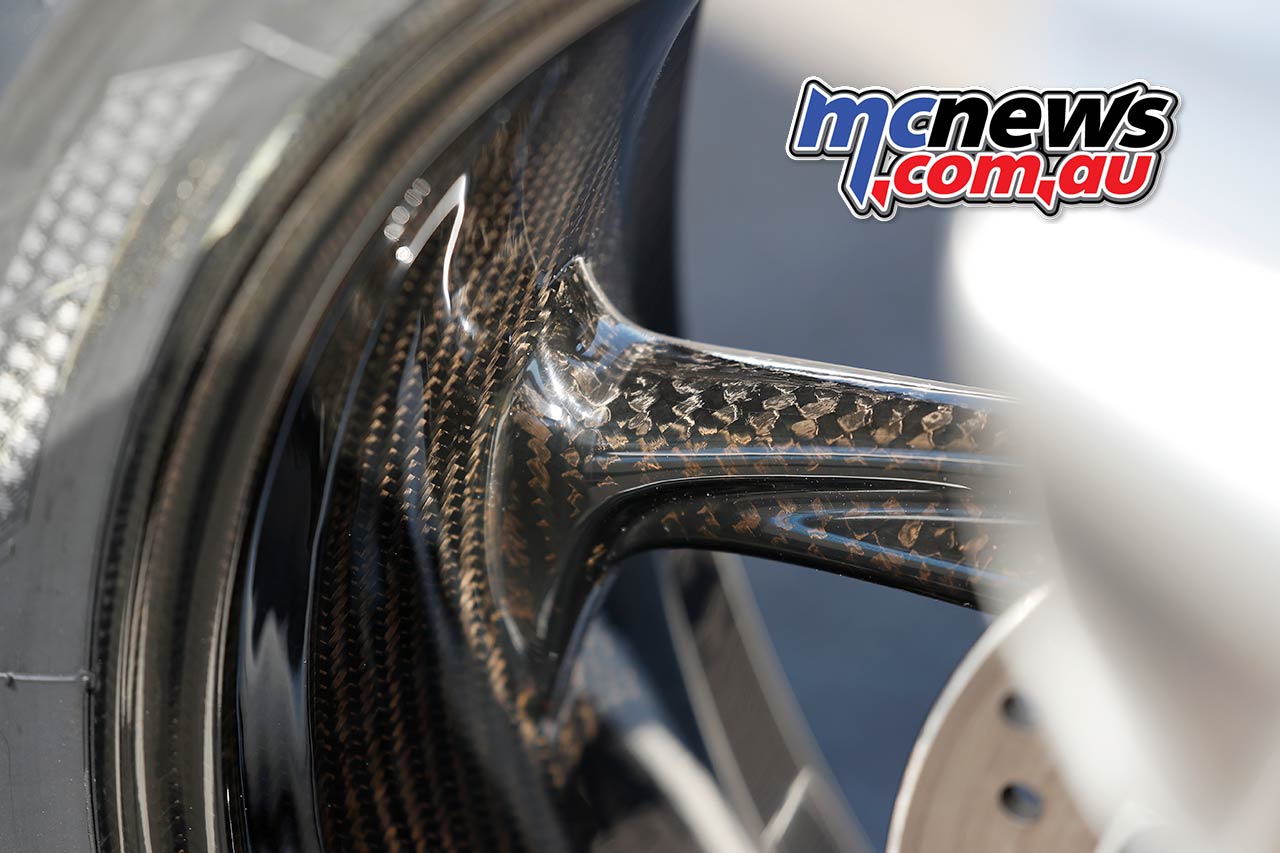
Where to start…
The Heart

The idea of creating an in-line four-cylinder sports bike occurred back in 2007, when engineers fitted the original K46 BMW designed engine in to a Yamaha YZF-R1 chassis, kicking off the first phase of testing. As we now know that model changed history, with the strong point being its top-end horsepower, while a lack of torque is and was a known issue. Over the years usability has crept in, but 2019 S 1000 RR promises a whole new ball-game.
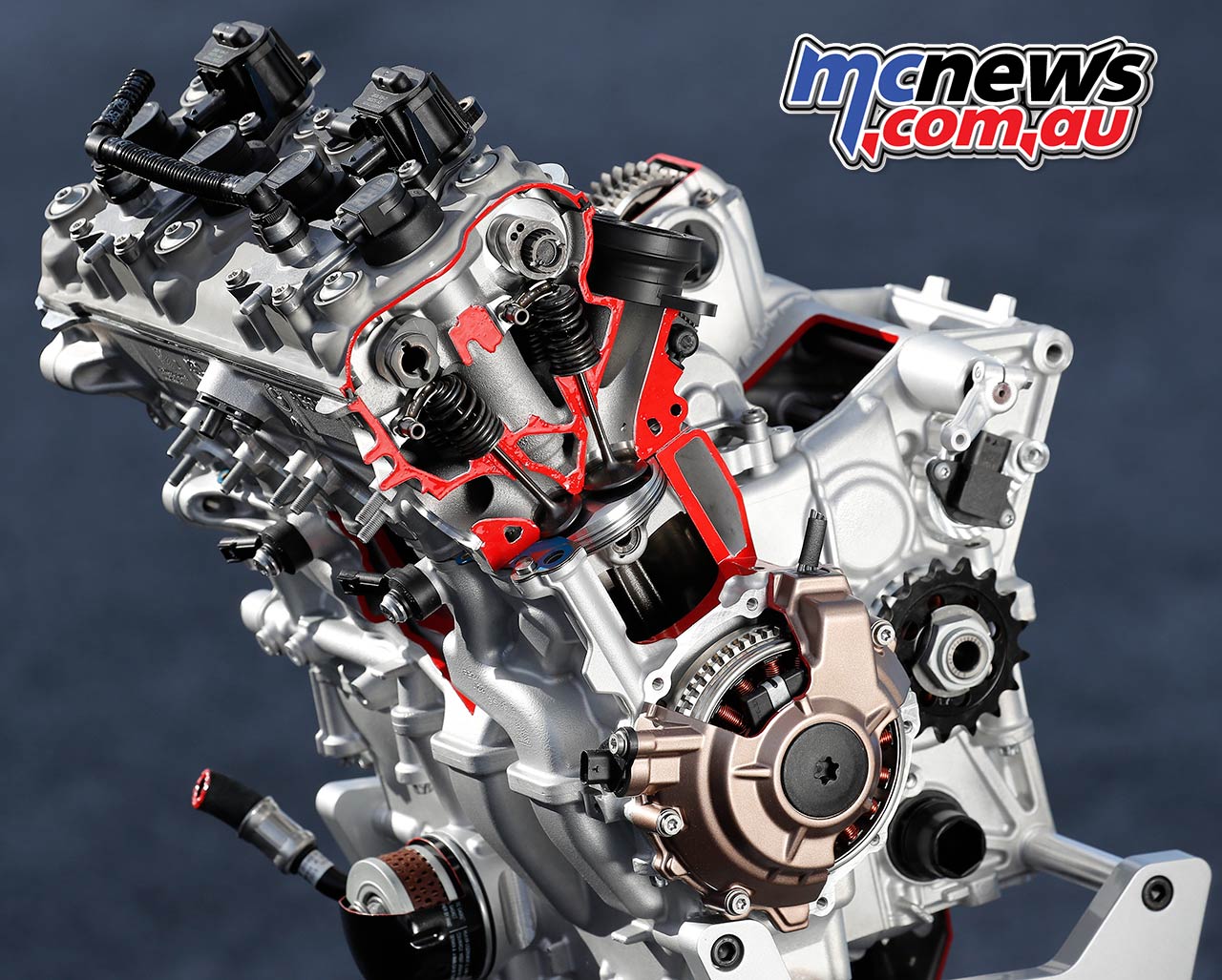
The completely new engine is packed with technology aimed at increasing horsepower and torque while reducing weight. A healthy boost of 8hp gives a substantial hit to the top end, but it’s the torque increase that has made the big difference at the seat of the pants.
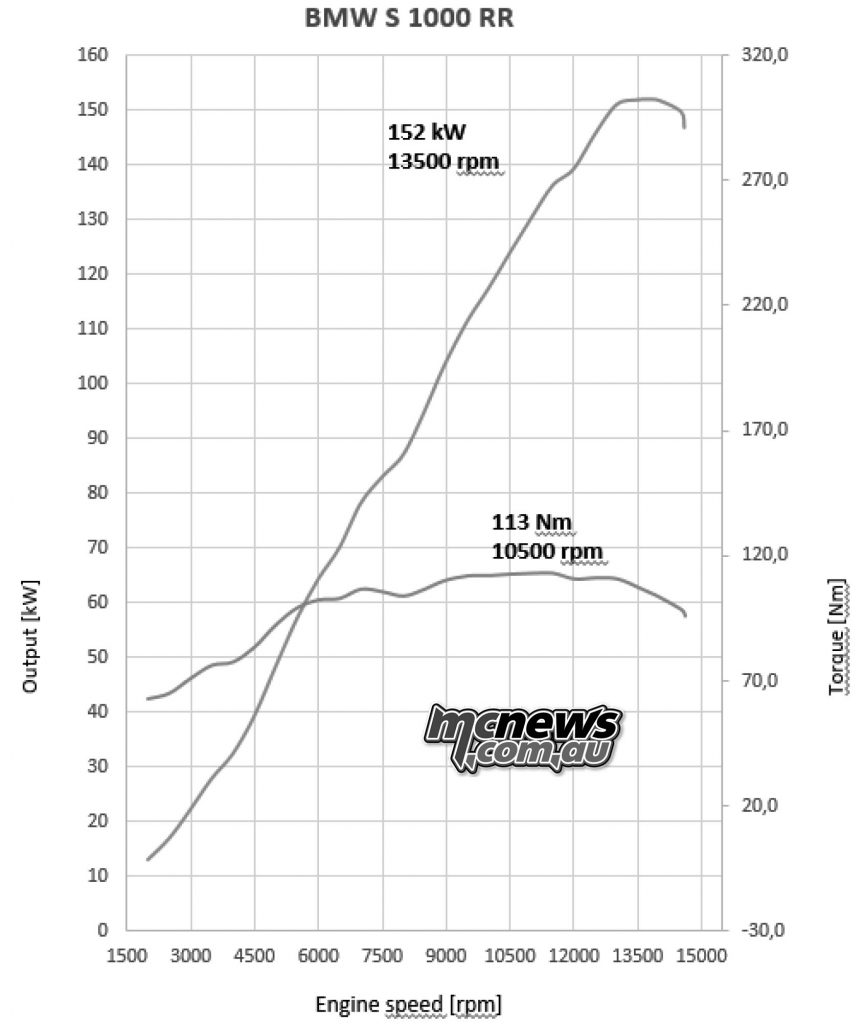
There’s now 113 Nm of torque on hand but across a much flatter and higher curve. The biggest improvement comes in the lower-mid rpm range. From 5000 rpm through to 7500 rpm the techs found a massive 20 Nm of torque over the original design.
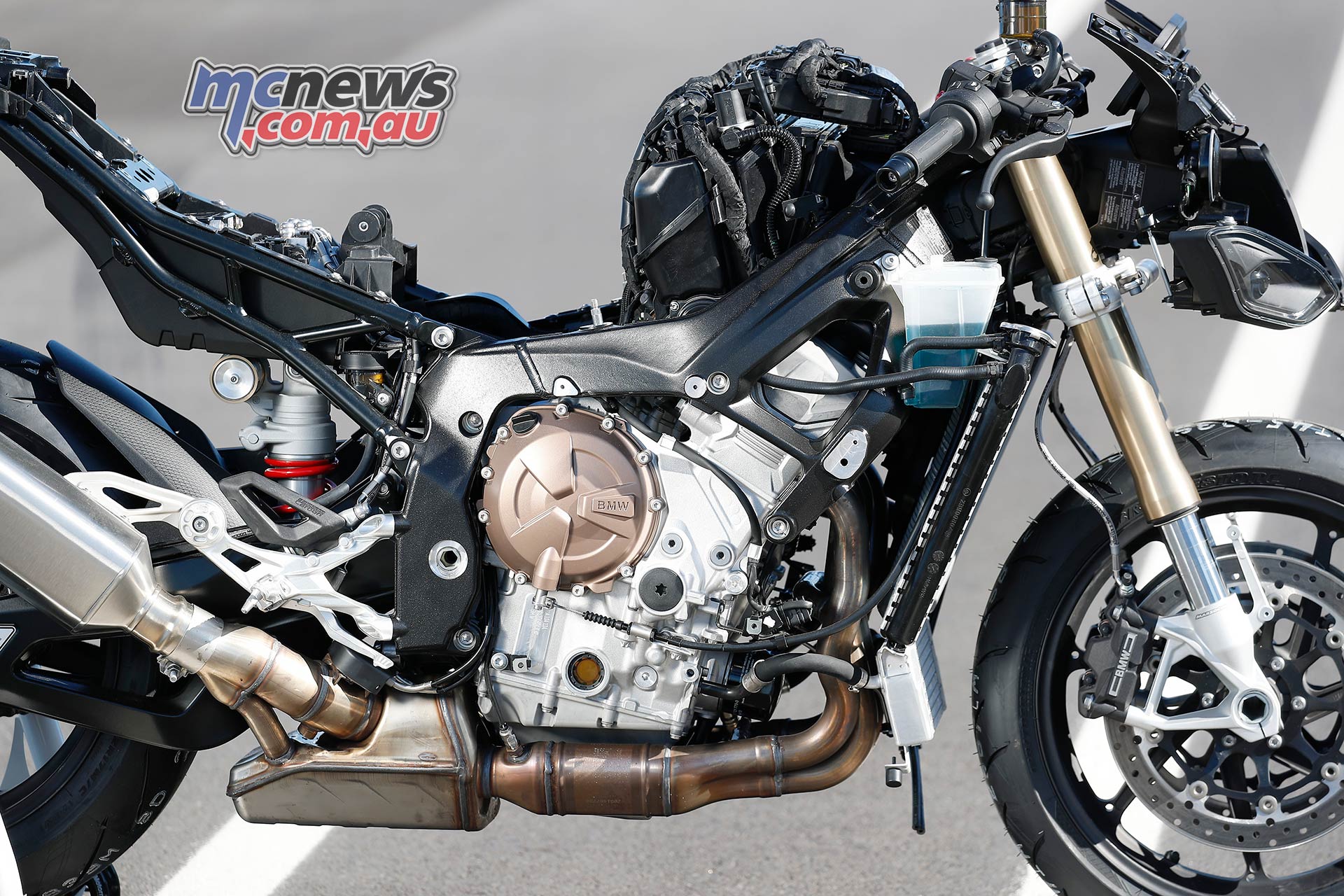
New gains have come from a complete redesign of virtually every aspect compared to the K46. The motor is narrower, four-kilograms lighter and yet incorporates the BMW variable intake Shift Cam system. It’s not a first with bikes like Suzuki’s GSX-R1000 and even the Yamaha T-Max sporting similar technology, achieved by a different method, but if there was a bike that could use it then the BMW S 1000 RR was it.
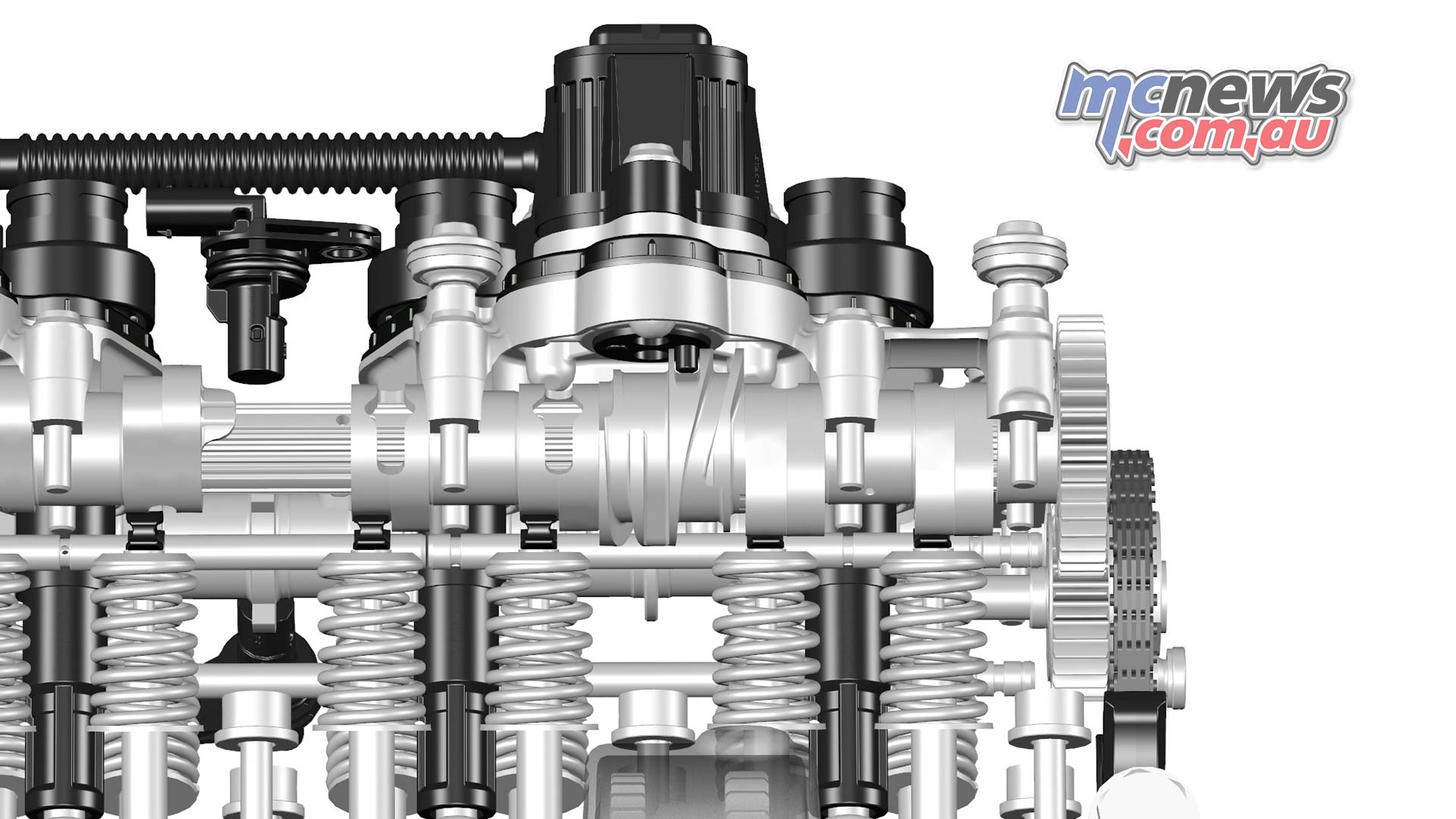
The BMW system works by changing the position of its cam lobes. Having two lobes per inlet valve side-by-side on a splined shaft.
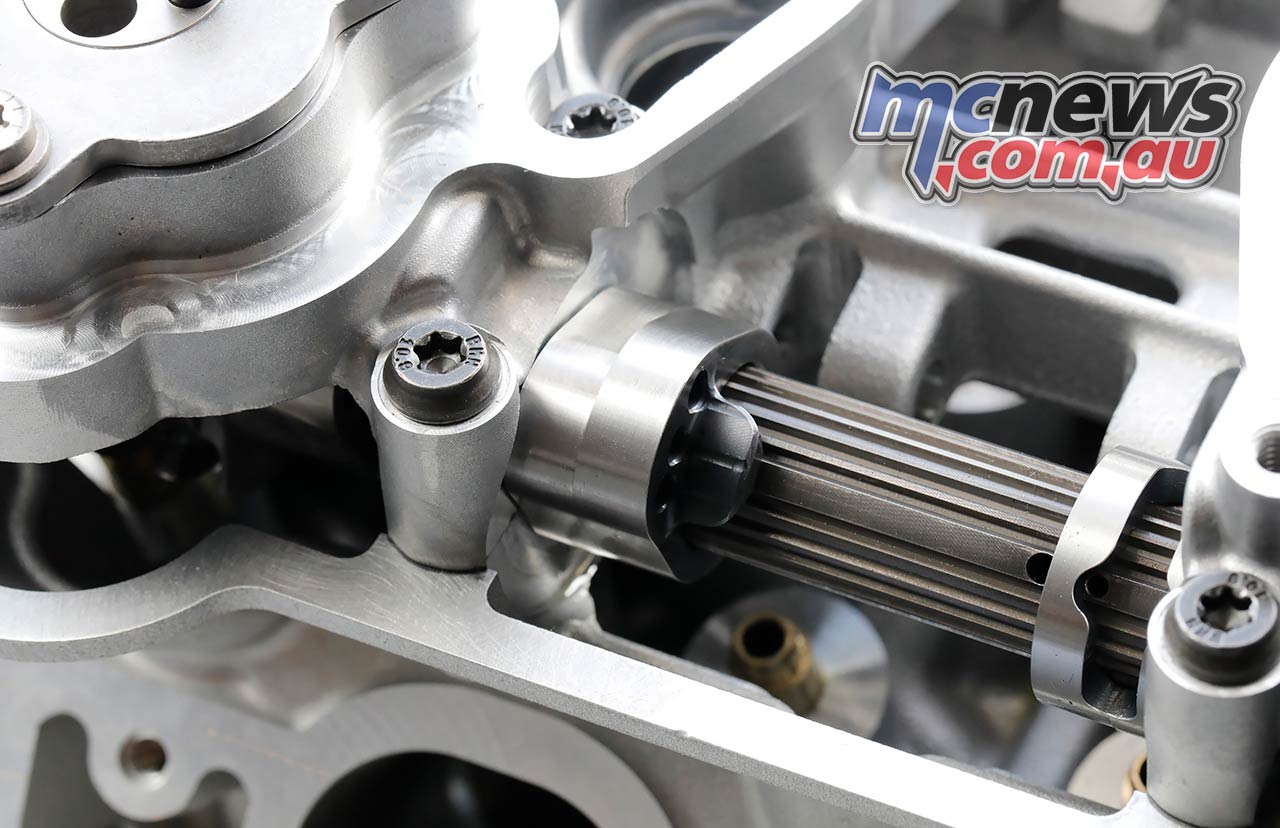
Just like a gearbox, the lobes slide on the shaft left to right, or vice versa, by a sort of shift drum that automatically changes from the torquey lobe to the top end lobe at 9000rpm.
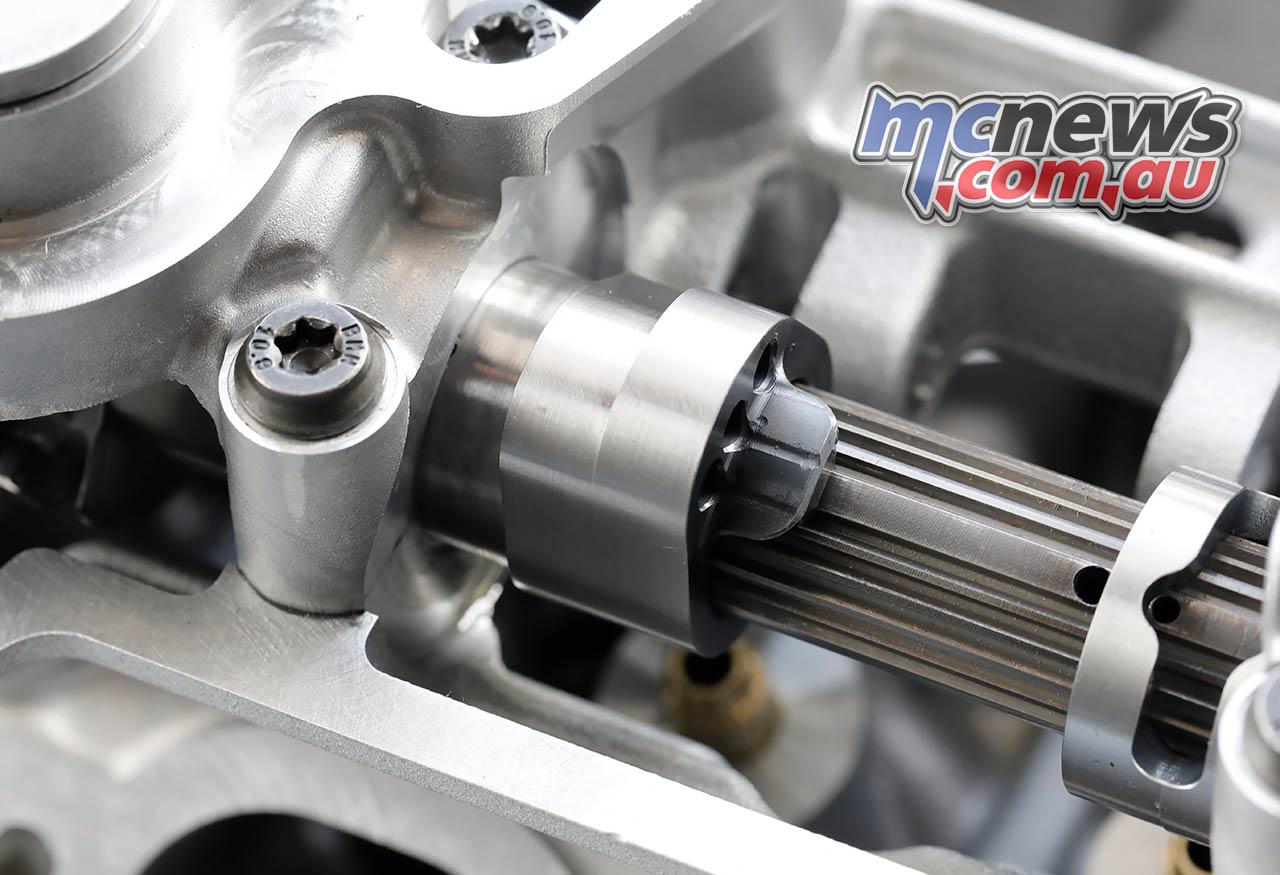
It’s a pretty simple system when you get a close look at it and much easier to understand when you see it, rather than when you just read the blurb.
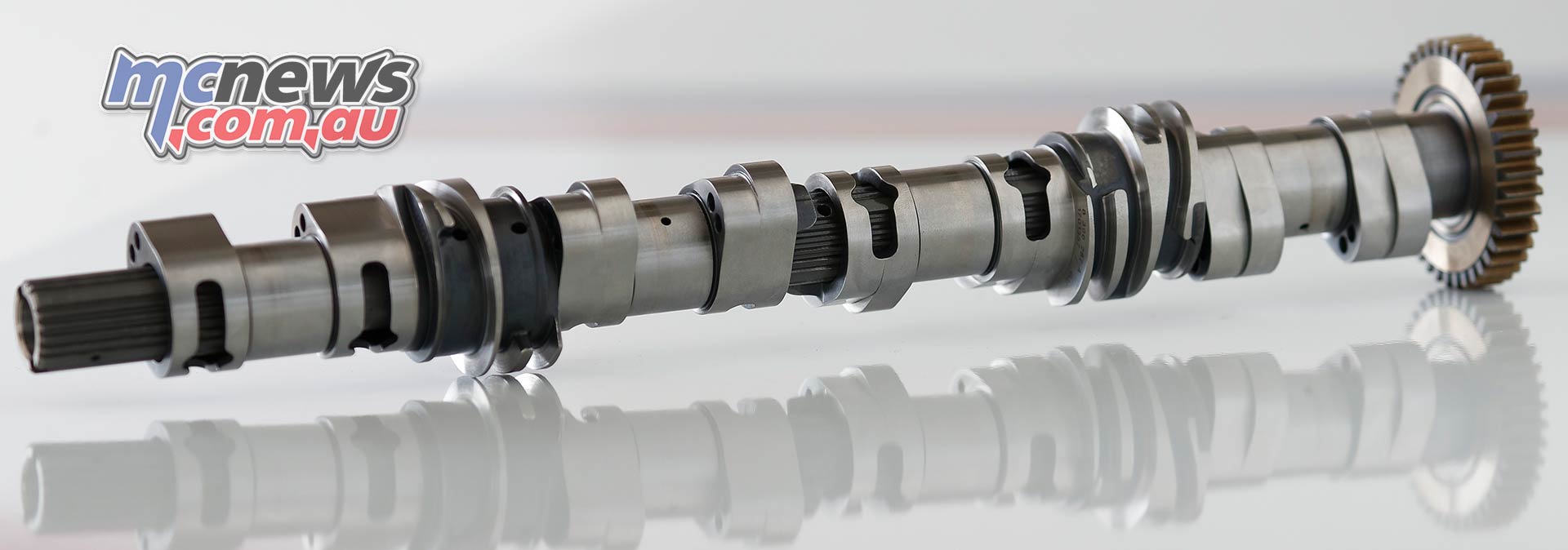
The cam moves lighter finger followers which tap the top of the buckets and push a set of new hollow titanium valves down, letting them do their work of sucking the air fuel mix into the combustion chamber four per cent more efficiently.
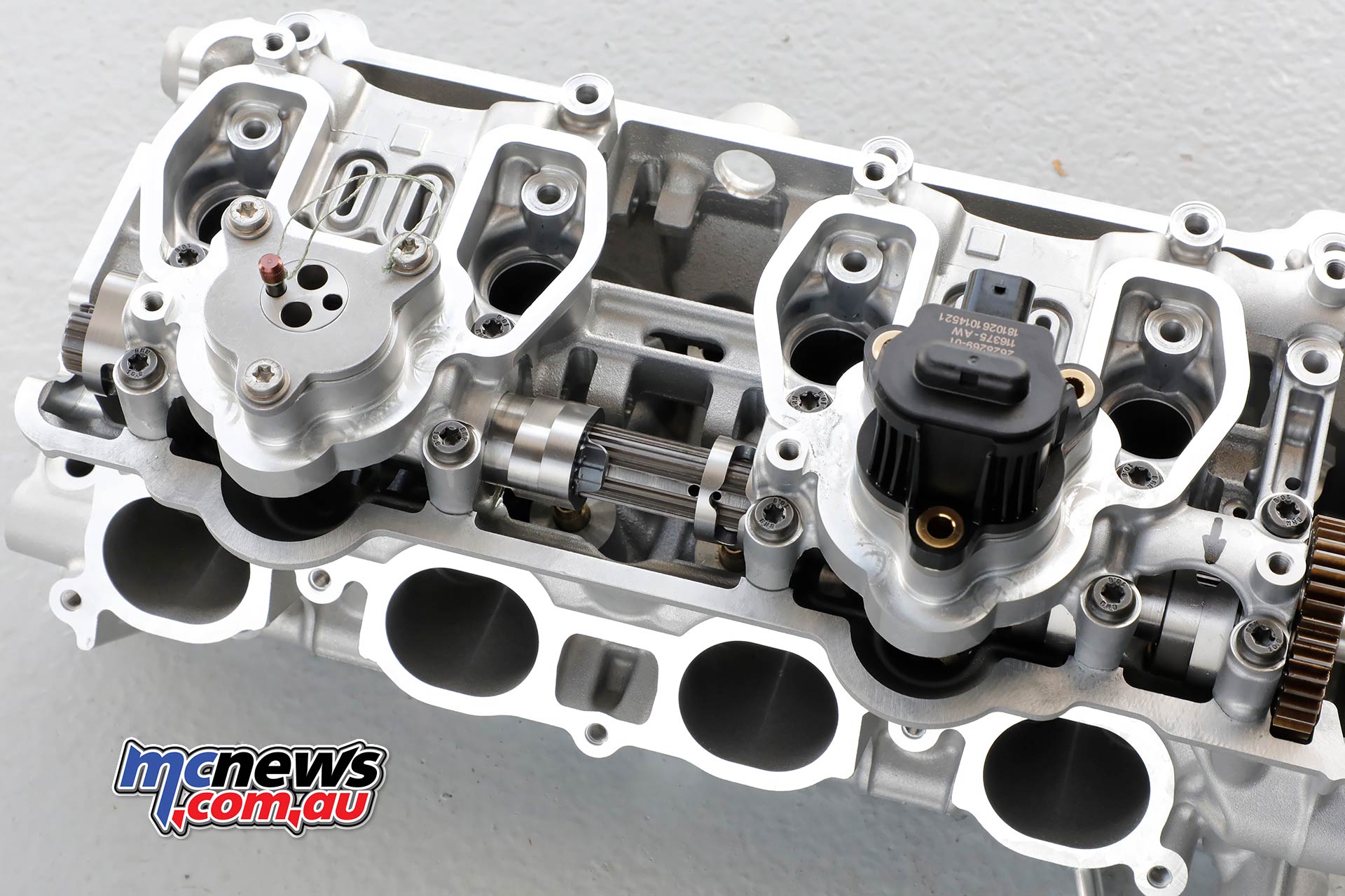
Paring weight from the valve train has allowed BMW to up the rev limit by 400 rpm, to 14,600 rpm, reliably. And with a substantially lighter crank it now gets there in more of a hurry.
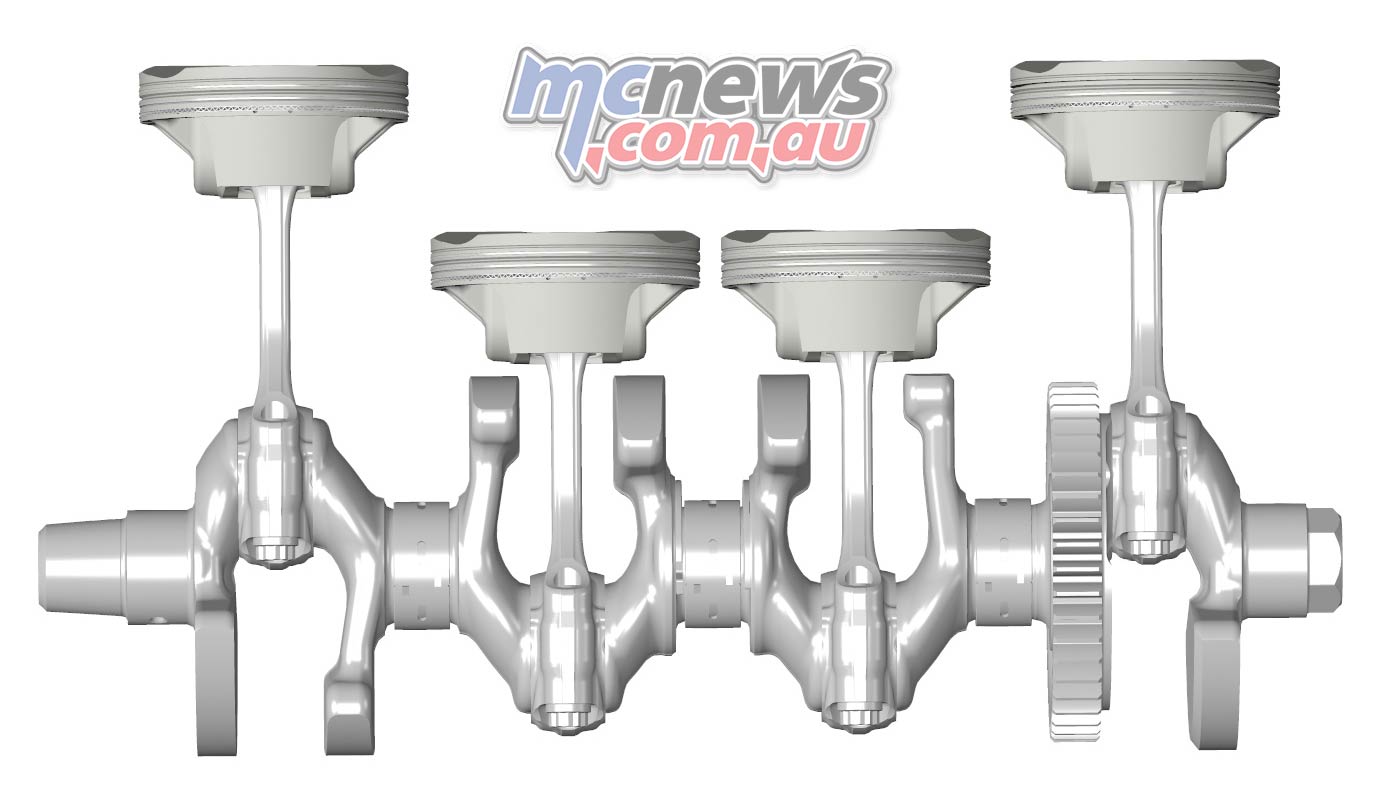
Its not just a top end make over though with improvements in water and oil flow being made via completely new crankcases that utilise a lighter all in one oil/water pump. A new smaller alternator draws less engine power to run, which increases efficiency and temperature regularity throughout the motor.
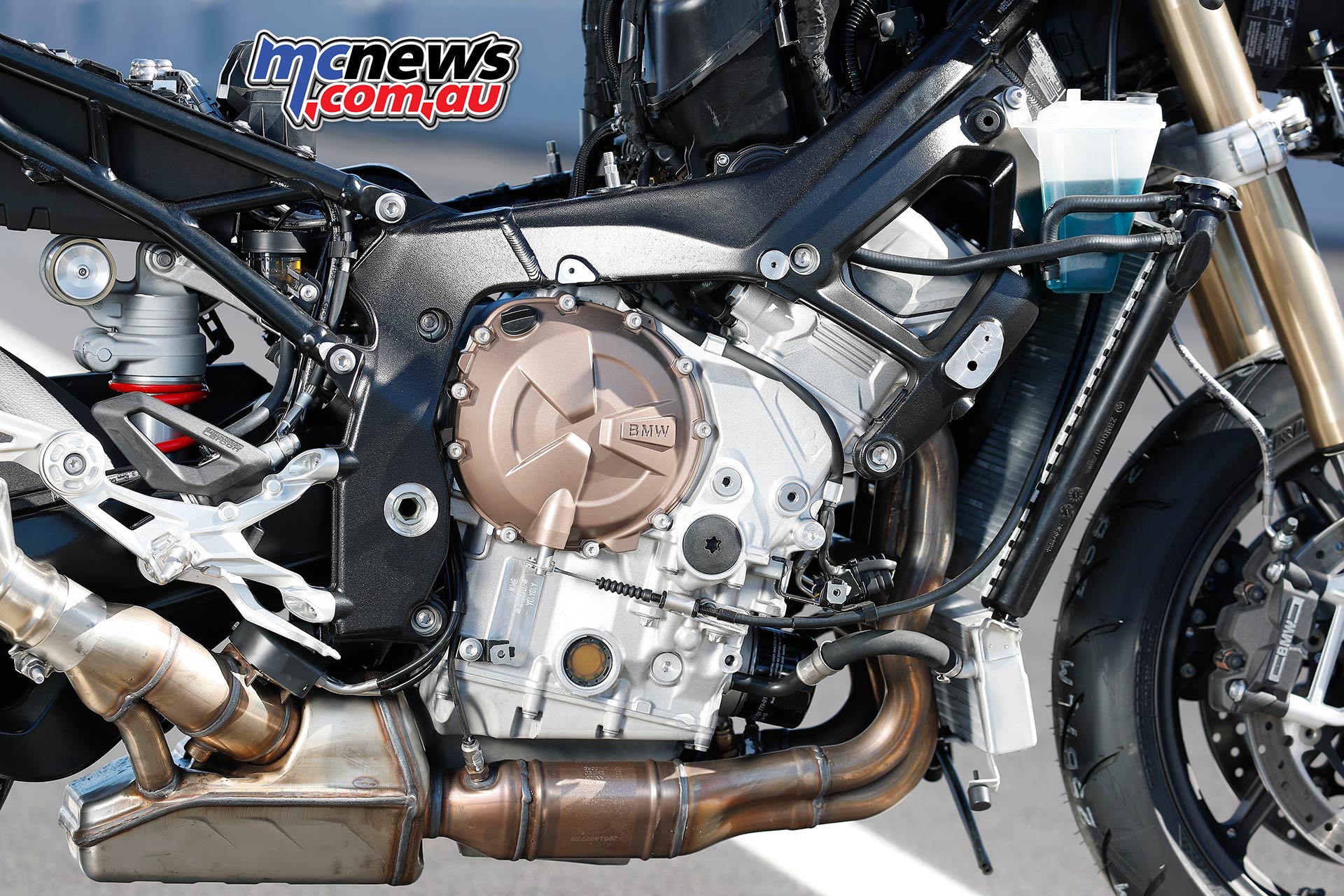
The extent of forward thinking is amazing, even the Bosch throttle bodies are set up to work in a split function so that at racing level engine cylinder pairs can work separately, allowing less power at major lean angles. Although not in use yet, the hard parts are on the bike ready to go when the software is proven.
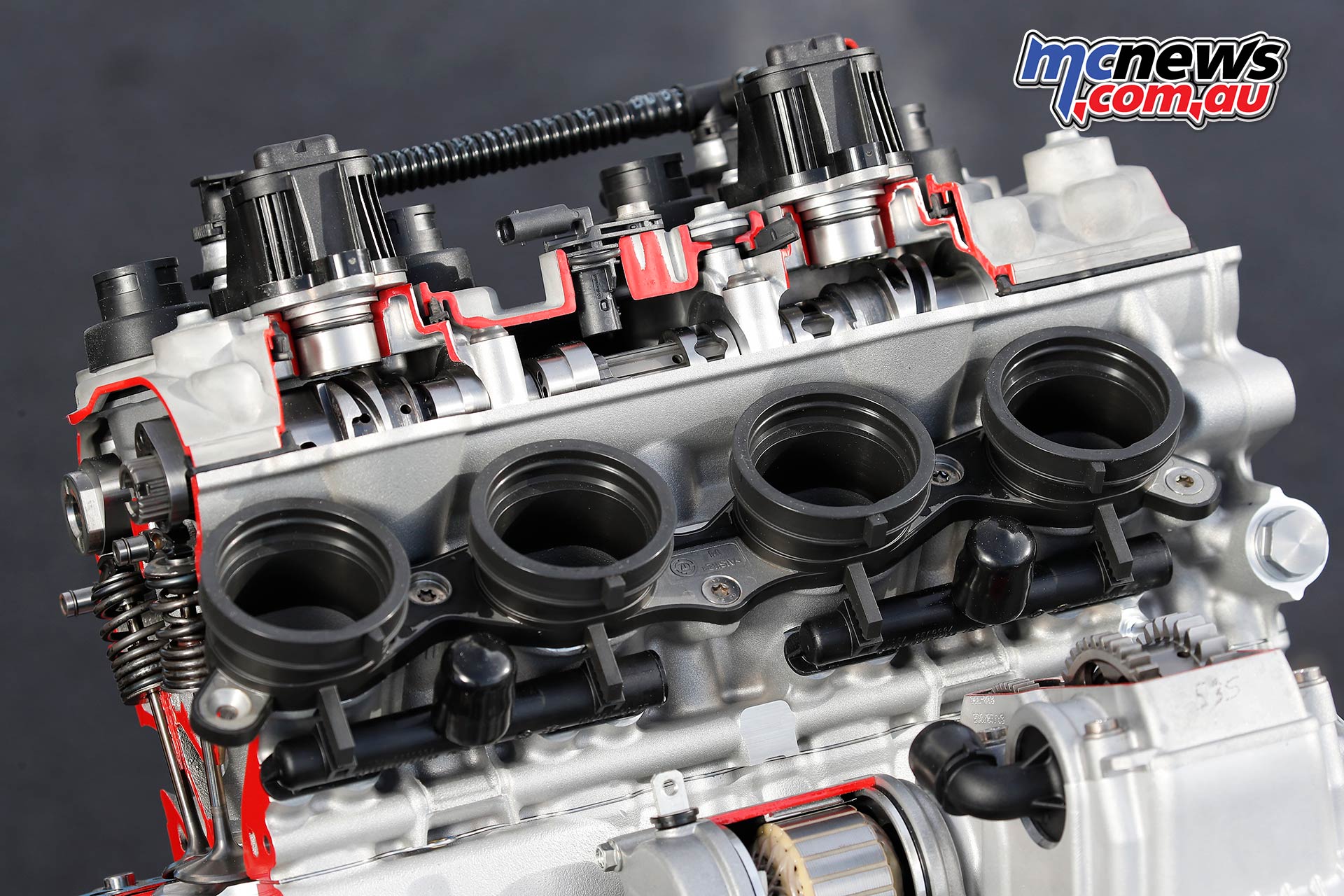
Electronics
You could write a large novel on the state of art Bosch system fitted to the new bike. Its functionality is much improved over the ‘18 model, a package that was already at a great level.
The M kit fitted bikes that we rode had three Race Pro maps and four standard maps – Rain, Road, Dynamic and Race.
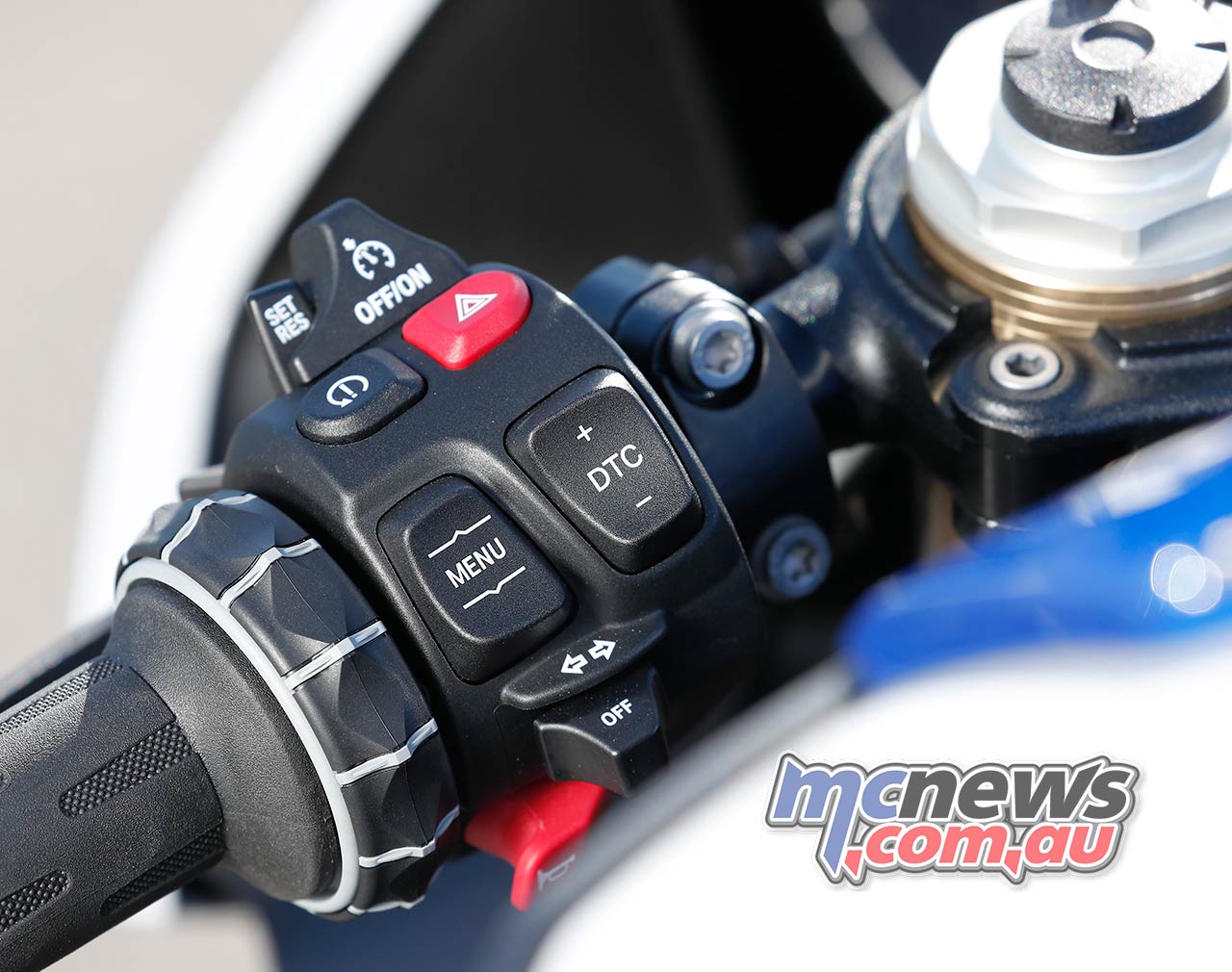
The functions are all easily adjusted through the various switch block mode buttons and the standard BMW twist toggle on the left side grip. The information is viewed on the new 6.5-inch TFT dash and it’s easy to read which is good, because there’s a lot of scope to change the parameters of your ride.
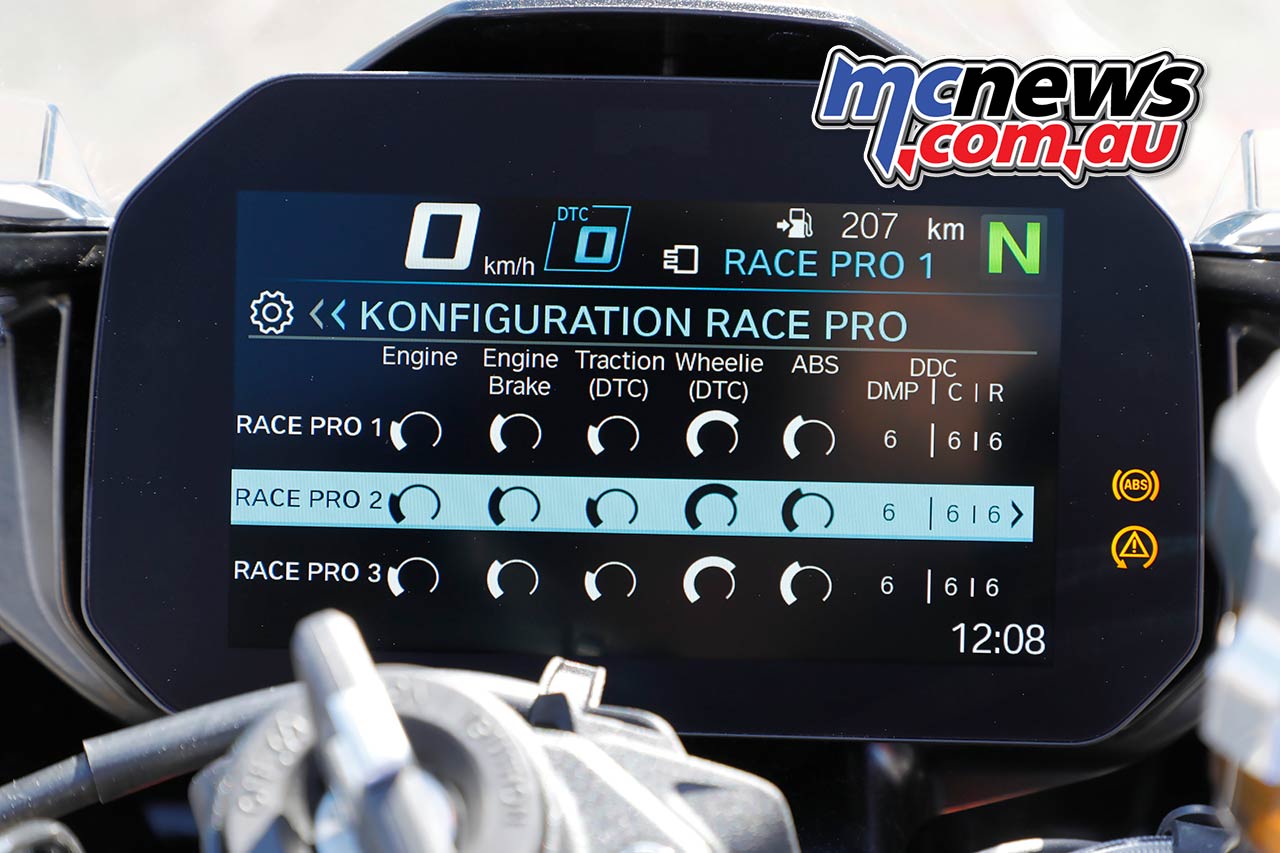
Traction control
The traction control is adjustable through plus and minus seven settings in every mode, and is changeable on the run. It feels a lot like a quality race item now to the point that the race kit item might not be needed, even for the serious punter.
Wheelie Control
For the first time an independent wheelie control is fitted and is high quality. It can be turned off and is actuated by many parameters but is not affected by traction control settings.

Throttle Response
The rider has the option to sharpen or soften the throttle connection line depending on his or her tastes. Both maps still have full power but it’s mainly the opening feeling that differs.
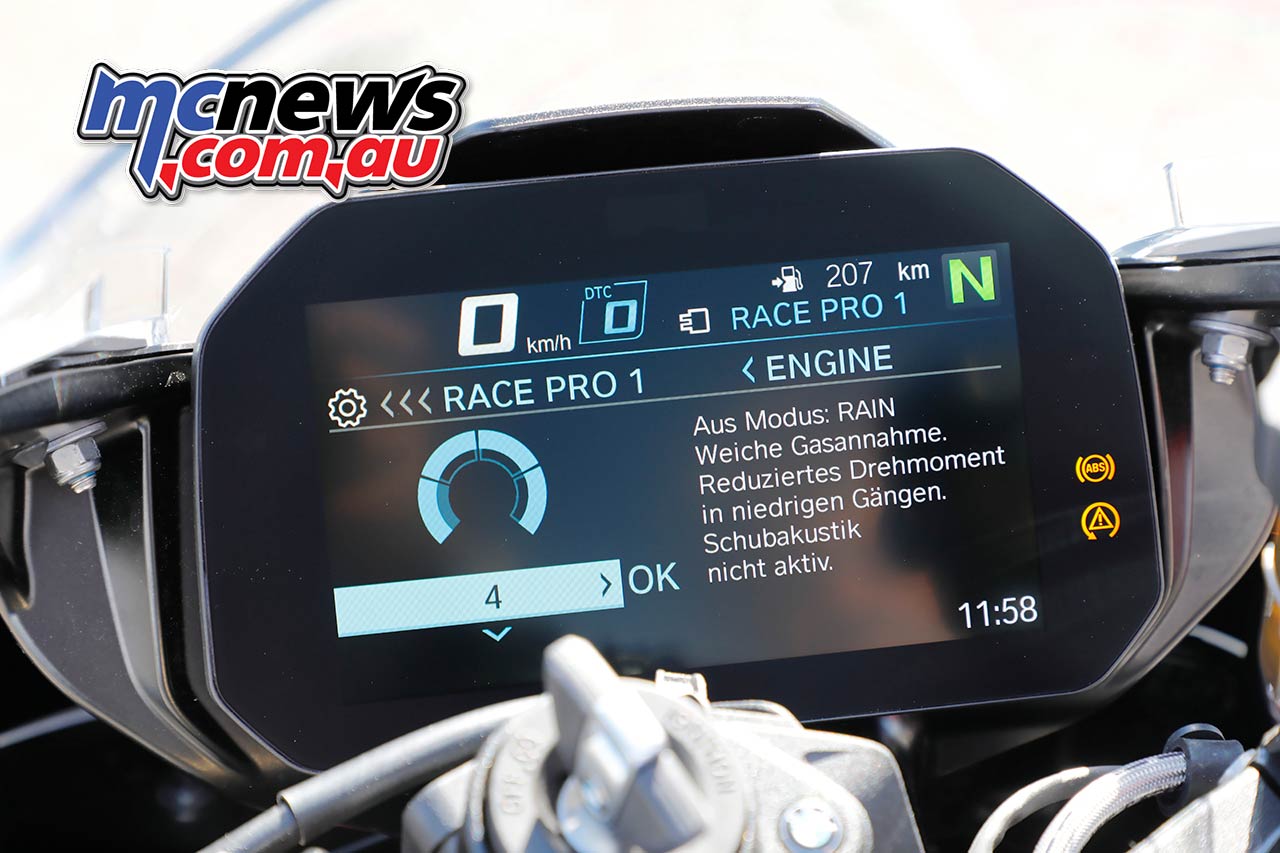
ABS
The ABS can be dynamic working in unison with the new tiny six axis IMU or can be manually adjusted with four different settings. It is lean angle dependent which makes it much more sensitive to condition changes.
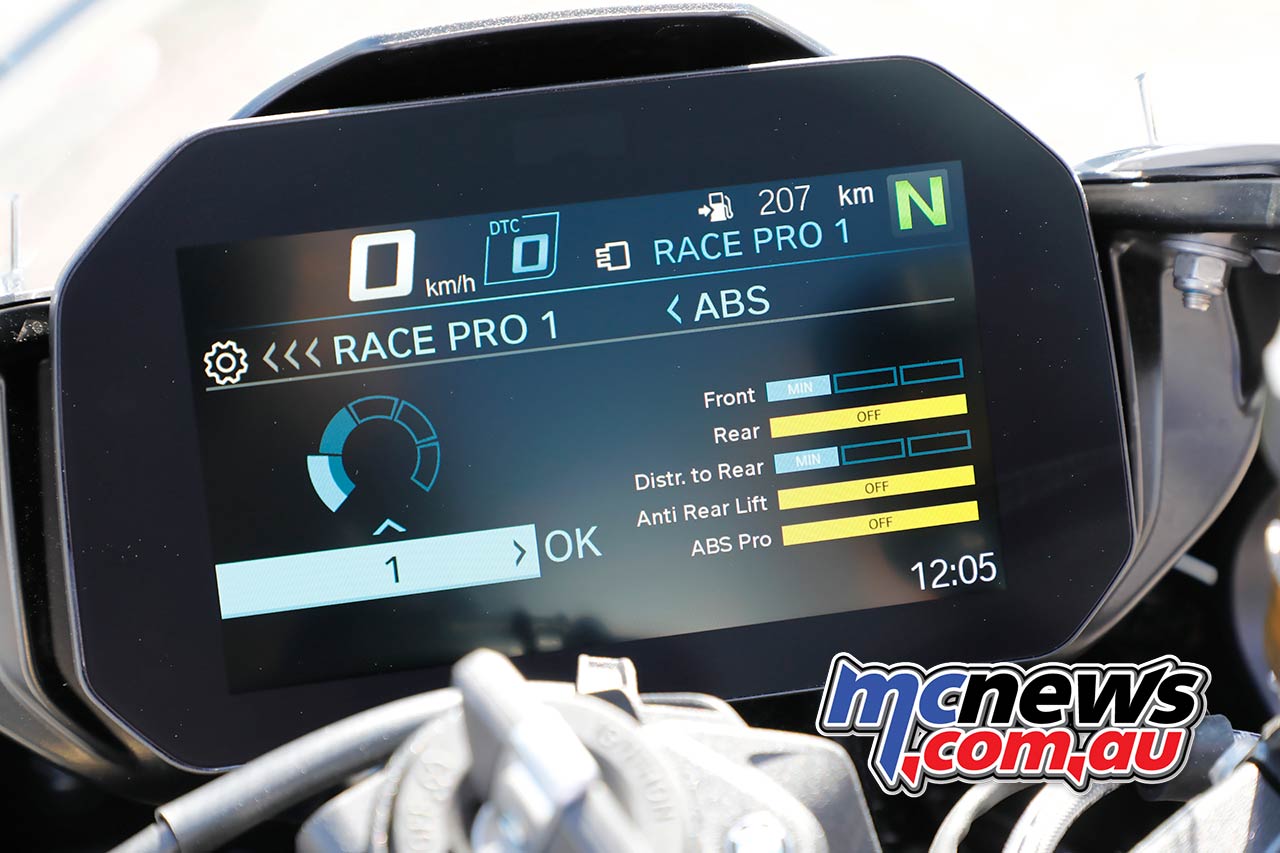
Engine Brake
Four settings allow the rider to let the bike back into the corner or enter with a freer feeling which is once again a great offering and one of the most important ones when it comes to on the limit lap times.
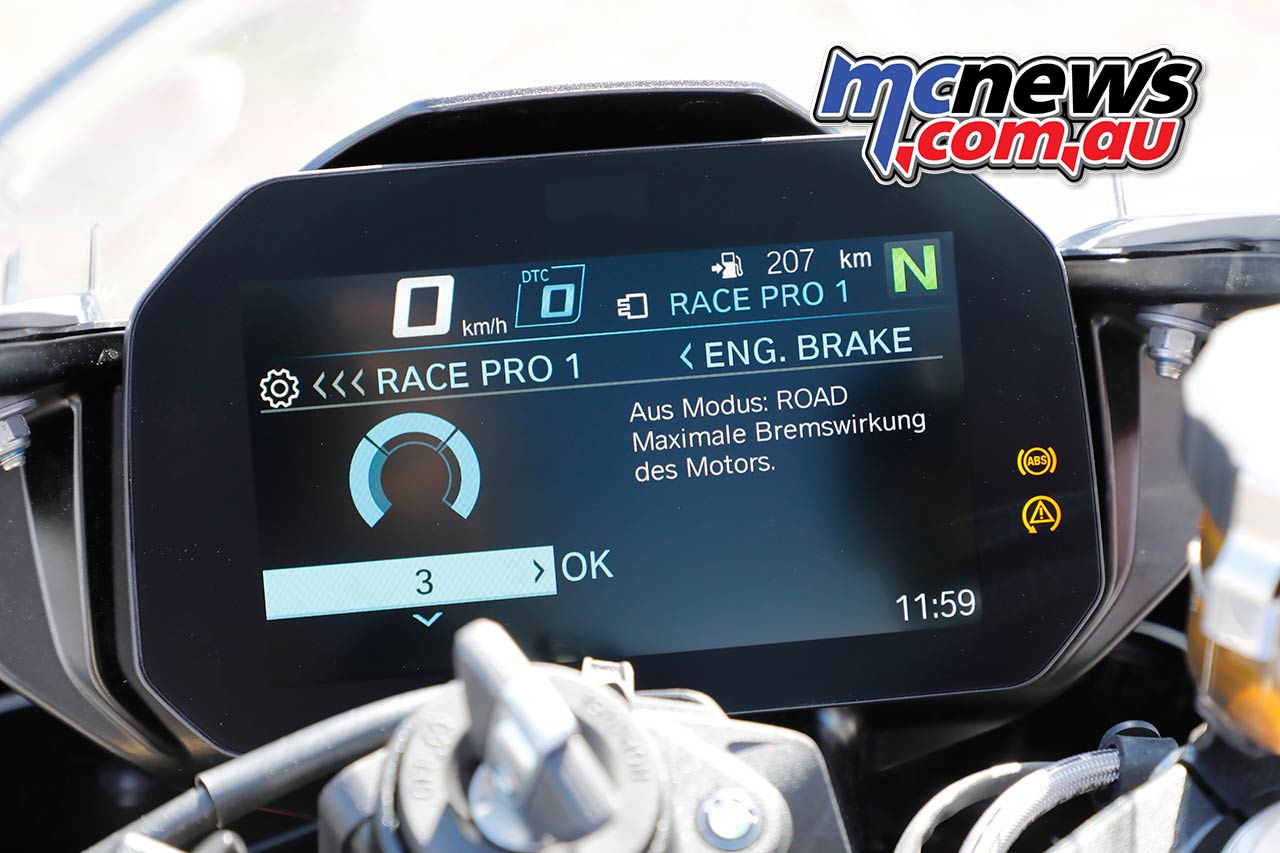
Shift Pro Assist
Standard on most bikes now allows clutch-less shifts up and down the box with auto rpm speed matching, just like MotoGP.
Hill Start
This year sees the introduction of hill start assist, which I guess could be useful.
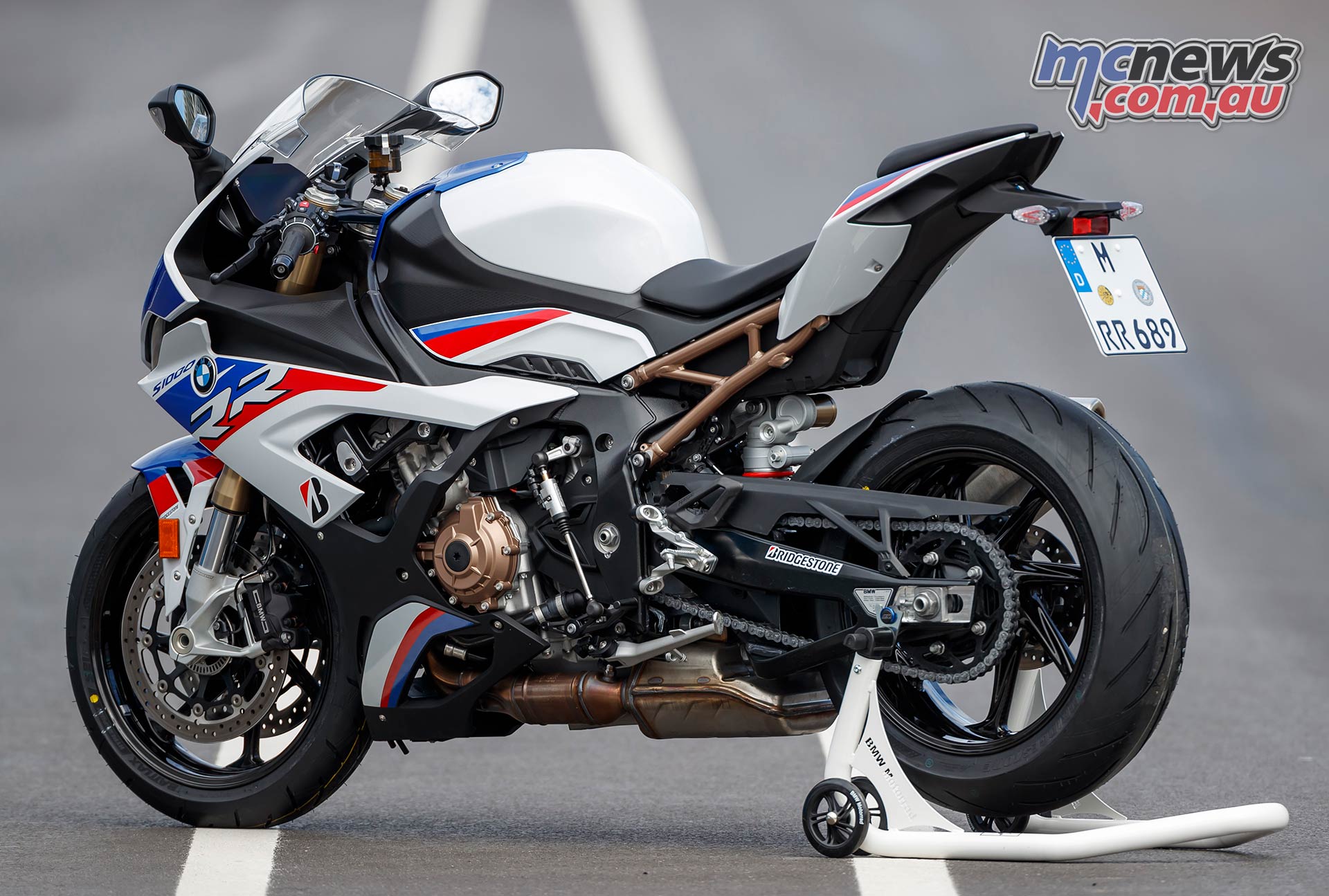
Launch Control
I didn’t use it at the launch, but if the old model is any thing to go by it will be fun to play with.
The rest of the package
There’s a lot more depth than the important items above but if you are serious at putting a new RR in your shed, I suggest you go to the dealer and have a play with the system. There’s different dash lay outs, cruise control, heated grips, connectivity, in fact that many goodies you will never be bored again.
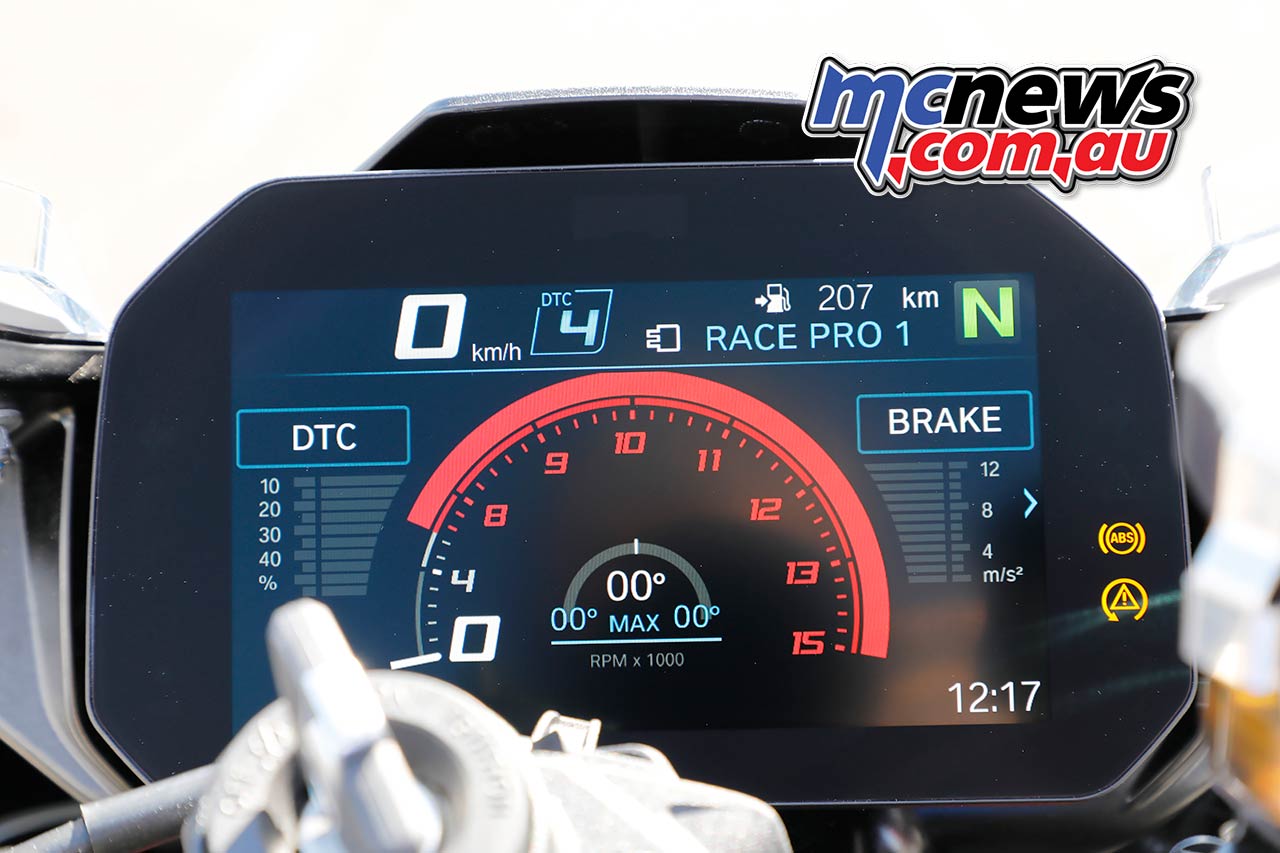
The Chassis
A lot of lessons have been learned by BMW Motorrad’s involvement in racing particularly over the last nine years. World Superbike races, Superstock World Championships, national championships and countless club races have been won on the old bike making it one of the most successful motorcycles over the period.

There was always an underlying issue though, and I know this from my seven years spent working as a development rider for the BMW factory.
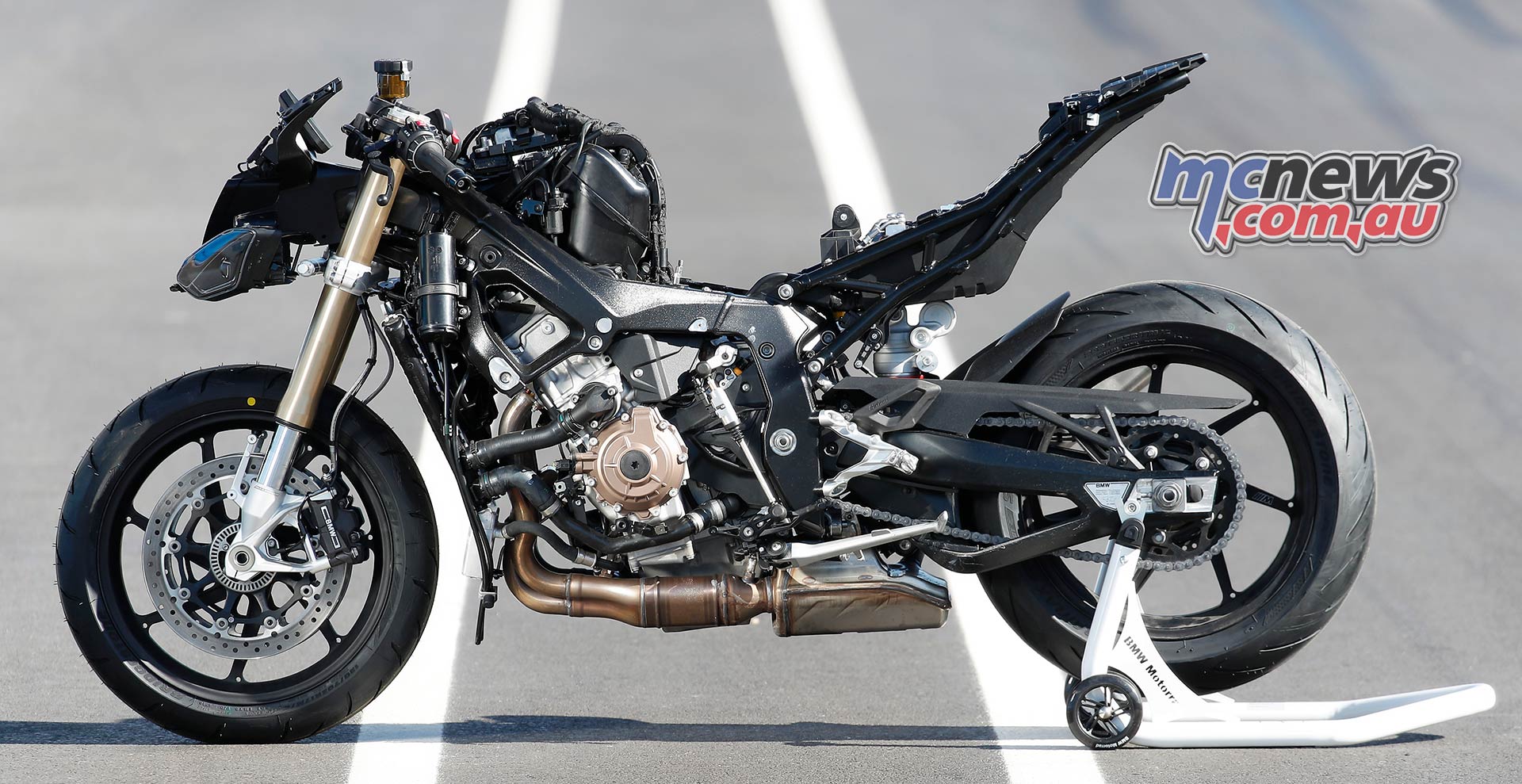
The frame was always too stiff, causing chatter and lack of bump absorption when at ten-tenths, literally making the suspension work over-time. The later models were a massive improvement, but the DNA of the old frame remained, until now.

With the complete redesign came a new chassis and swing-arm built specifically to put right the issues of the past. The engine is now part of the equation being a stressed member, it helps tie the feel of the new RR together. BMW call the new chassis a flex-frame, with absorption being a big part of its job. Not only from road conditions but also different frequencies created from engine rpm and vibration.

The lighter alloy twin-spar frame has an all new one-piece swing arm with an underslung brace, as seen on most MotoGP bikes.
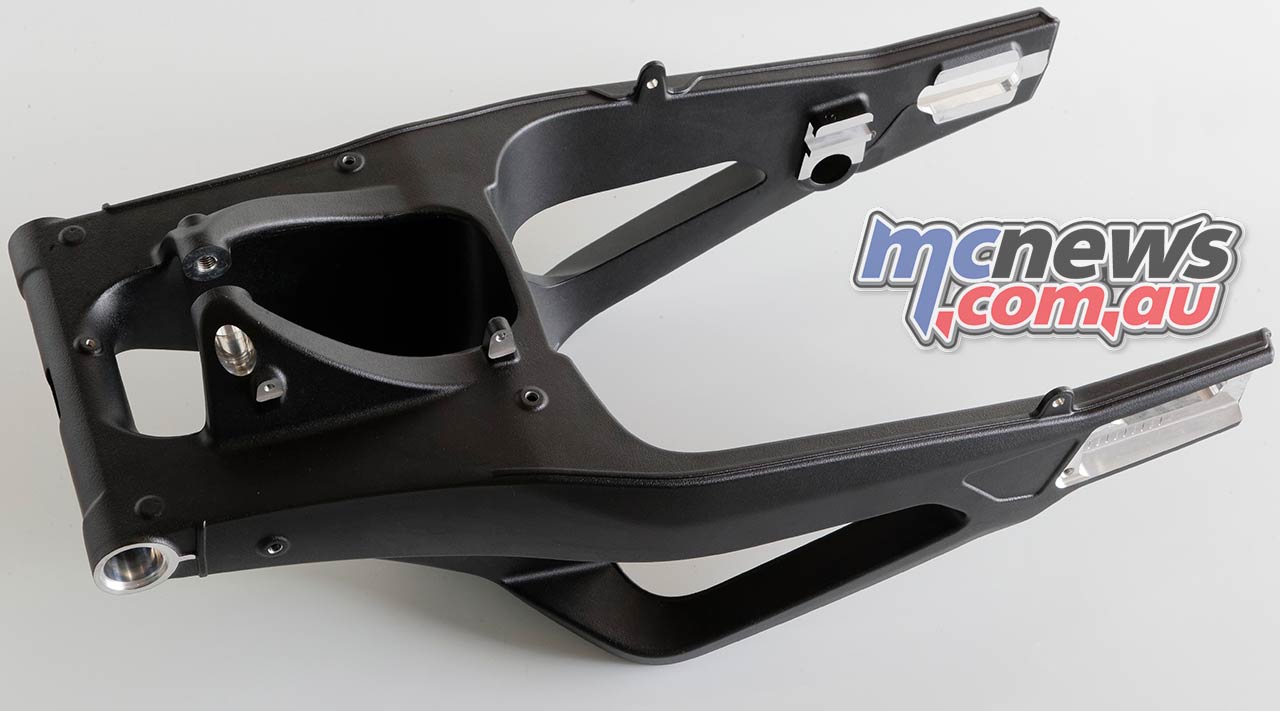
Apart from looking neat it gives a lot more room in and around the shock, making it easier to remove or change a spring when things get serious.
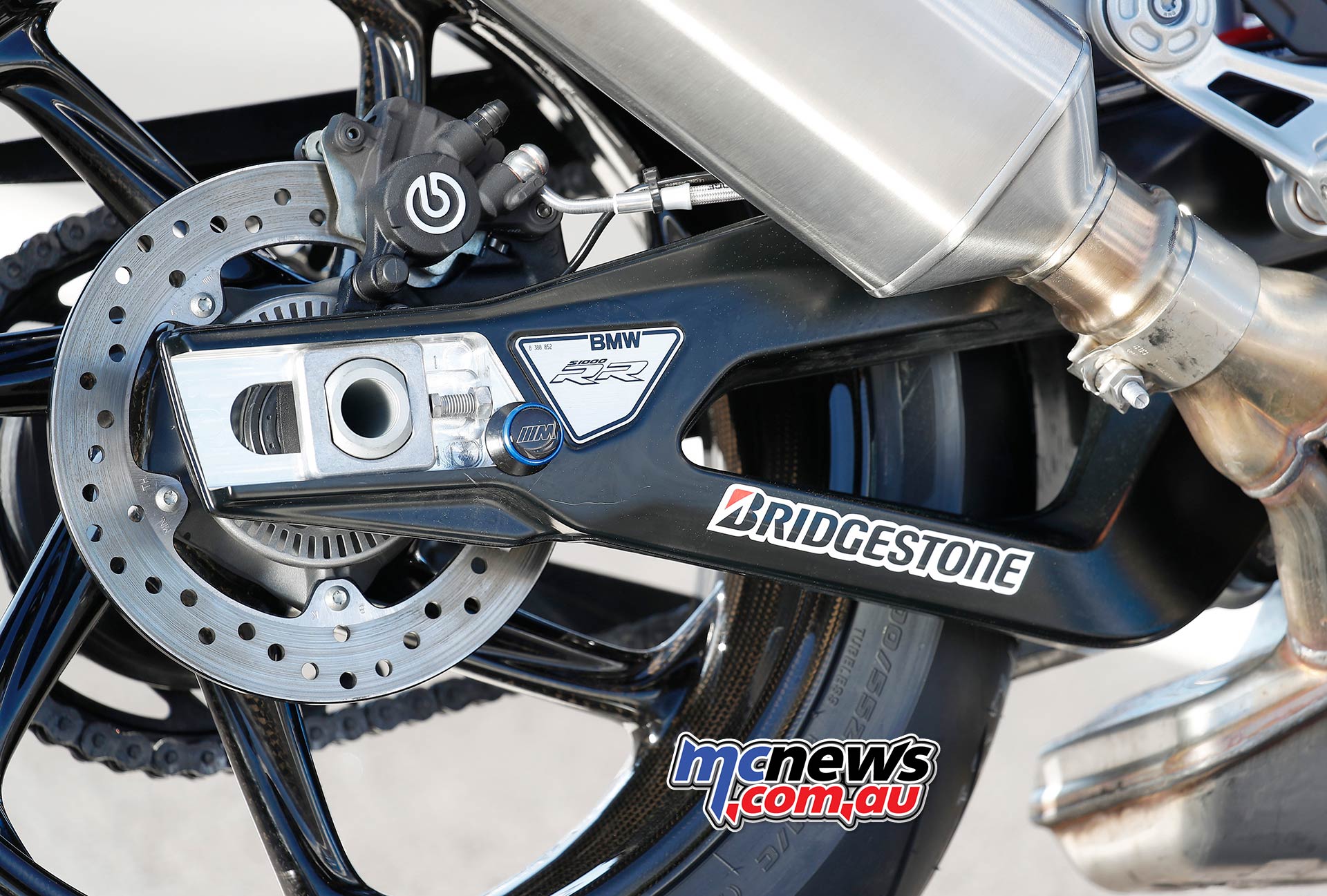
The shock is also moved away from the engine’s heat which helps to keep it cooler.
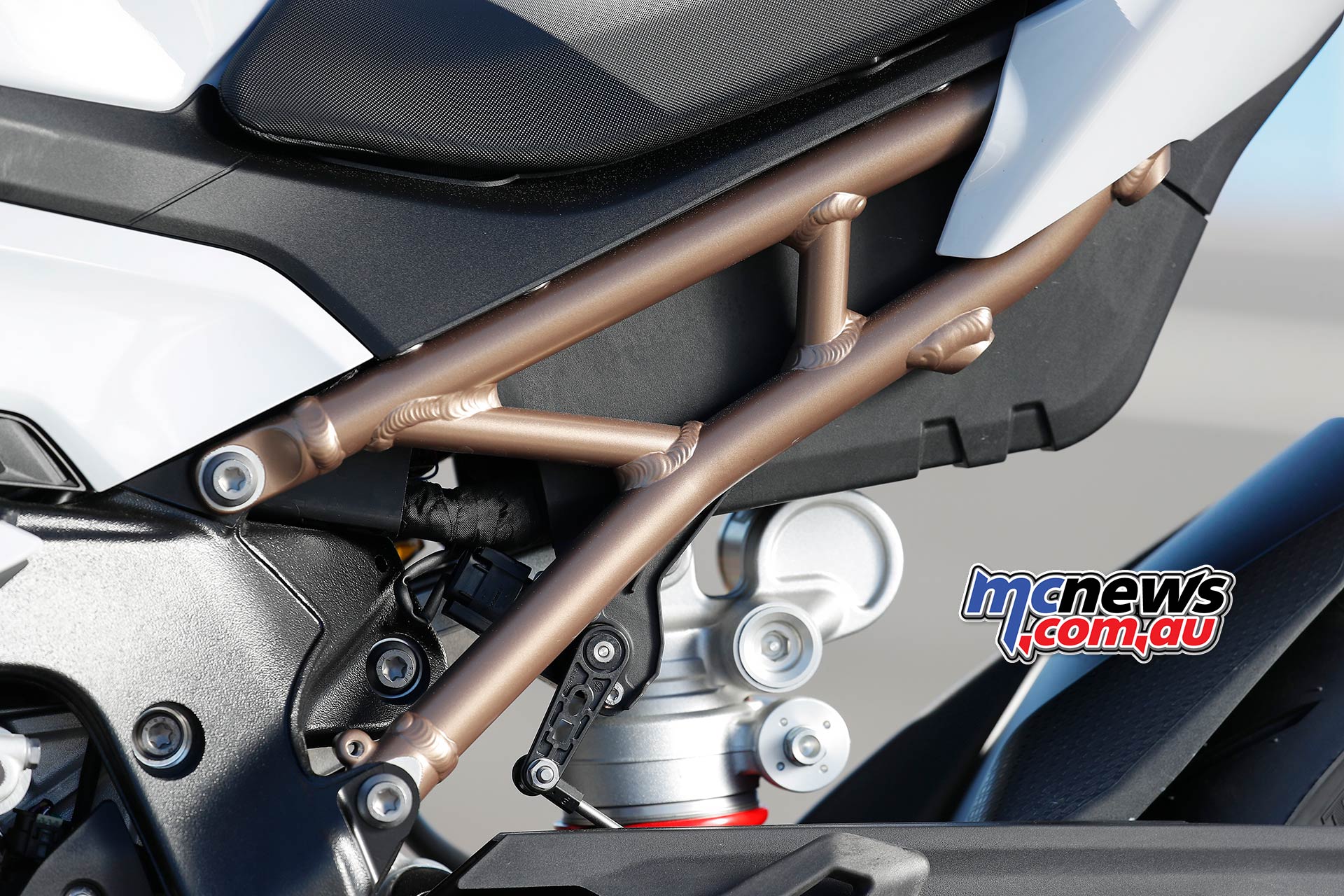
Change of partner
Sachs fork and shock packages adorned the S 1000 RR right from the start, but this has all changed for 2019 with Marzocchi becoming their new partner. Its not just change for the sake of change though, with BMW using a shim stack front and rear that works alongside an electronic adjuster that is linked into the ECU on its Dynamic Damping Control equipped machines (like the M).
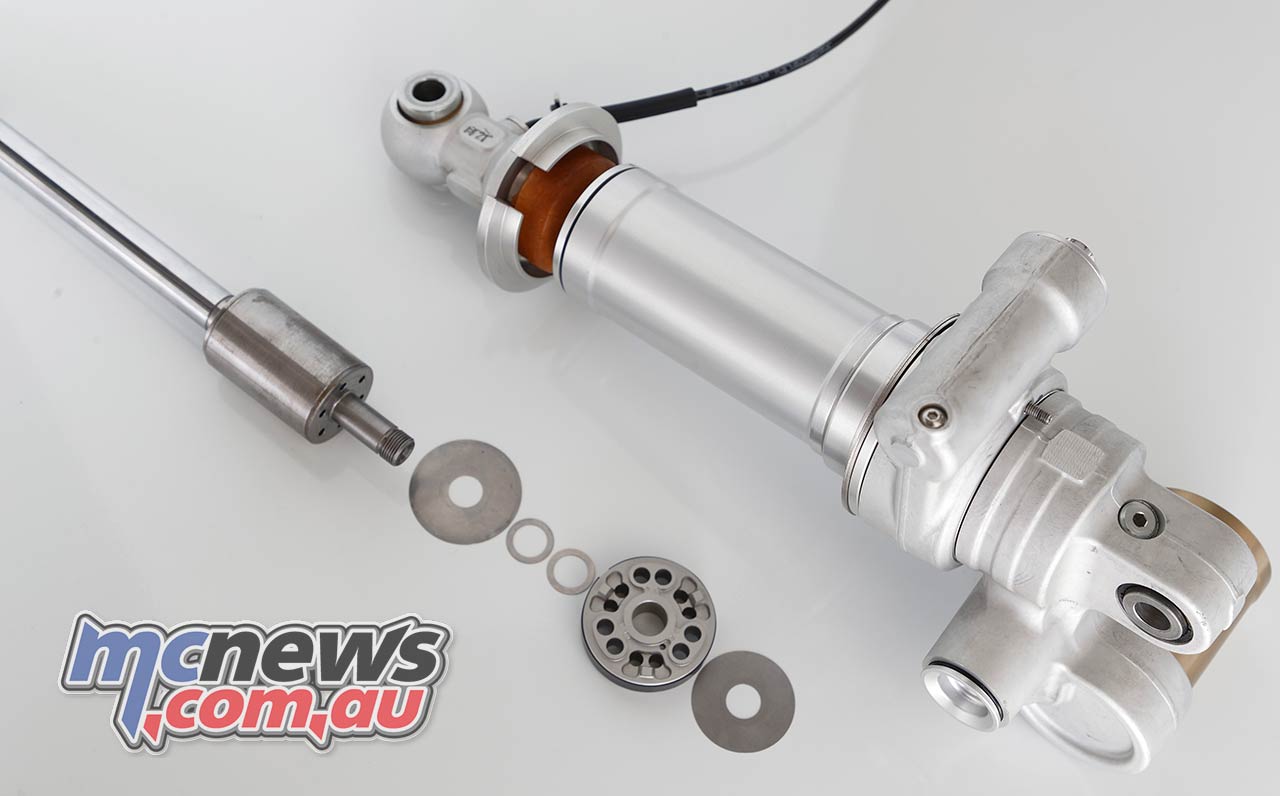
It is a complete departure from the old Sachs system which used an electronic valve that opened and closed its size to alter damping. The new system is like riding around with a screwdriver attached to the clickers that can be set, or be continually adjusted in dynamic mode.
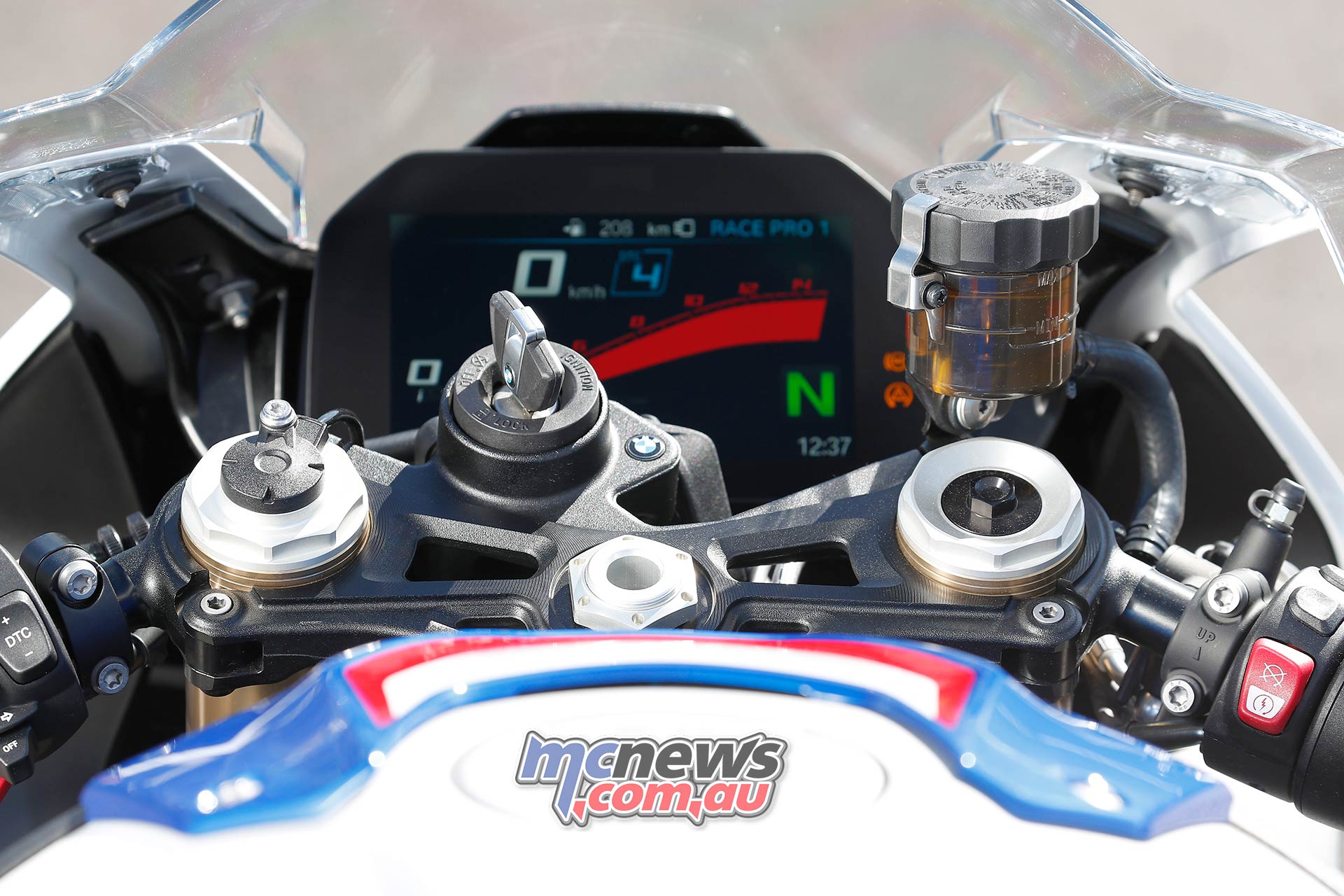
Brakes have moved away from Brembo to an American made Hayes caliper. It was chosen blindly by the BMW test team after a rigorous testing program. I still can’t get a believable answer as to why. A Nissin master cylinder is used to apply the pressure to those Hayes calipers. Just to keep everyone happy there’s a Brembo rear caliper.
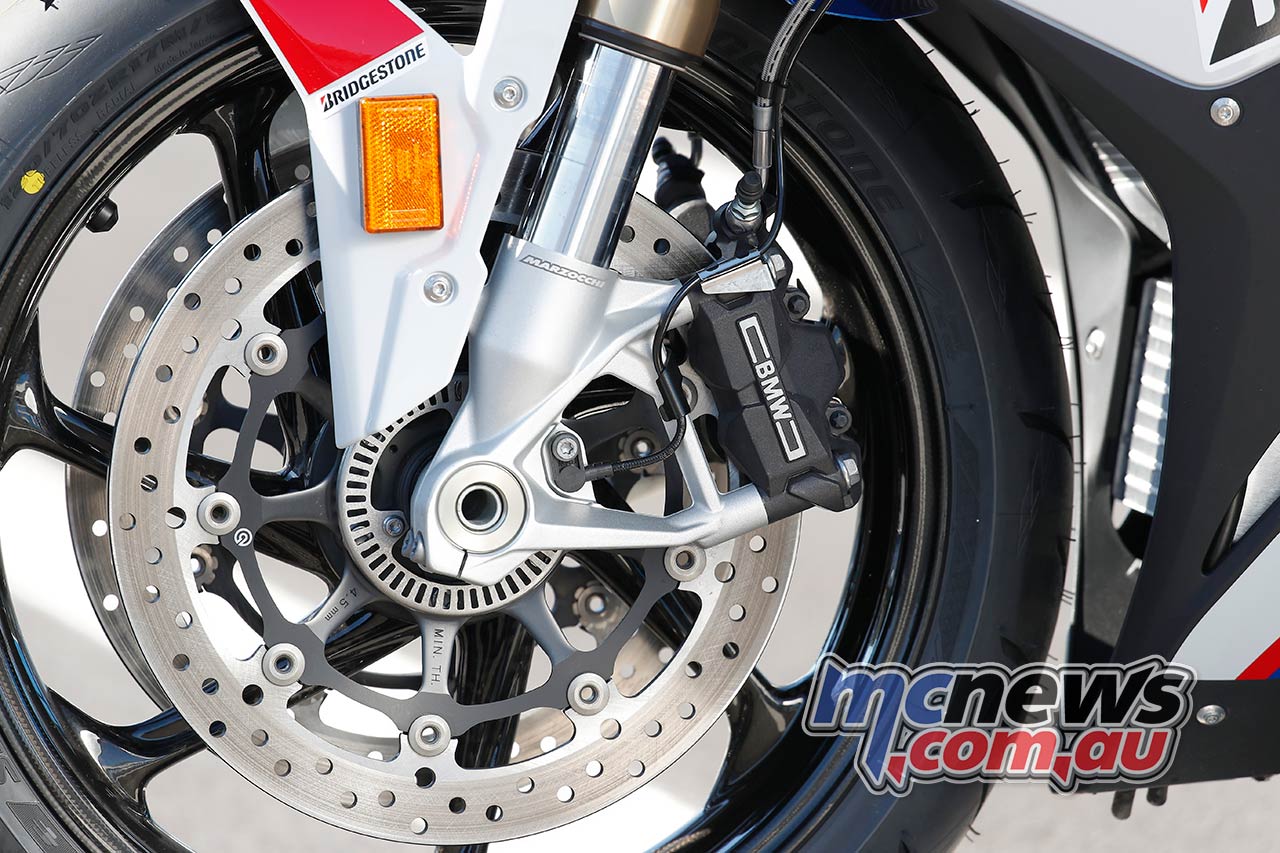
Ergonomics
You can forget that familiar feeling if you are a current owner of an S 1000 RR as this machine is completely different. The rider gets a feeling of sitting in the machine rather than on top, as I felt was the case with the old bike, and the bars are set a little wider than the previous bike.
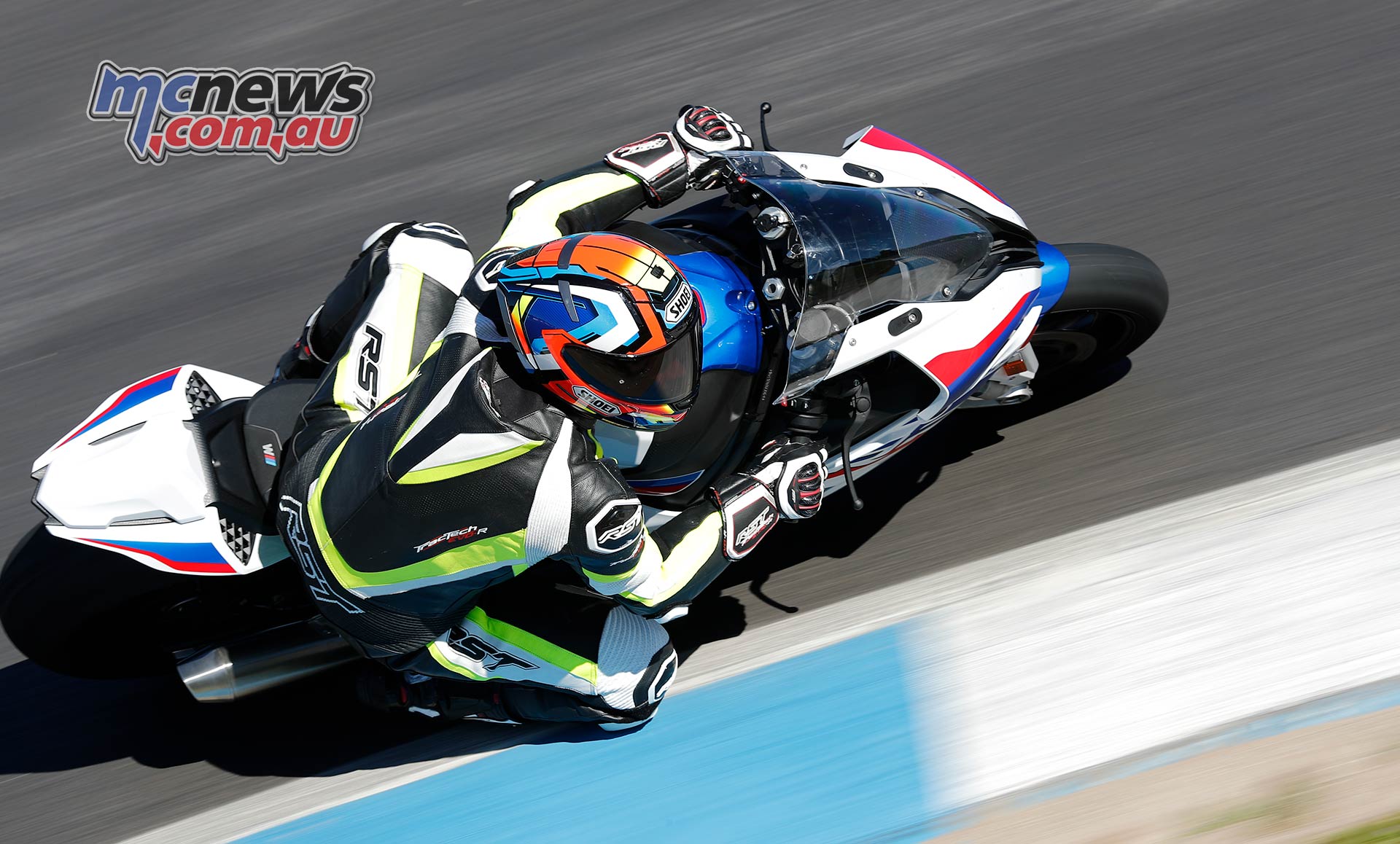
The new TFT dash is a master piece to look at and has really updated the cockpit to give it a modern feel. The integration of the available rider aids with the new switch blocks works well and is pretty self-explanatory.
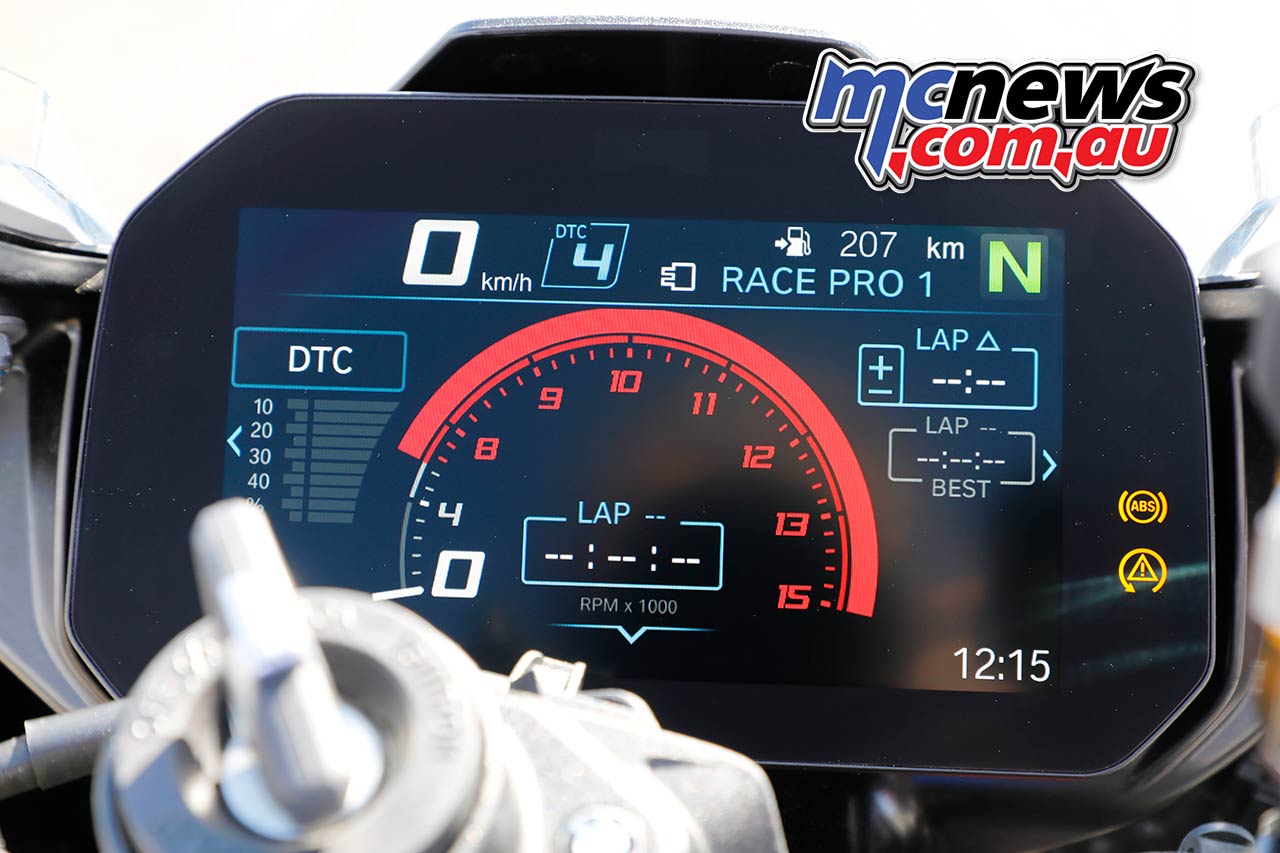
Heated grips are easy to find and activate, as is the cruise control. BMW have spent a lot of time making user friendliness a high priority.
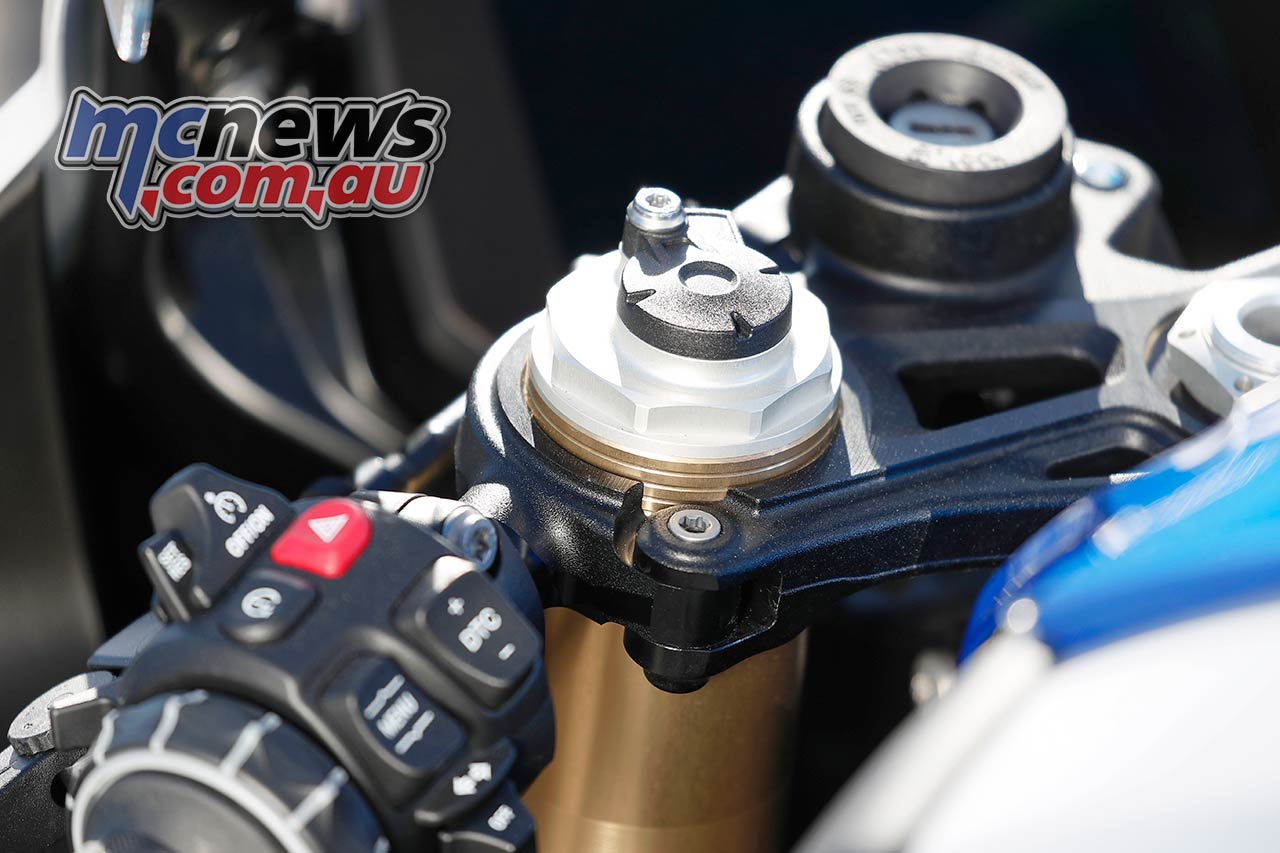
Ok, but what’s it really like?
Estoril in Portugal was the idealic setting to test the bike and a day blasting around the twists and curves of the ex-GP circuit was a great way to get a taste of the bike and the improvements made.
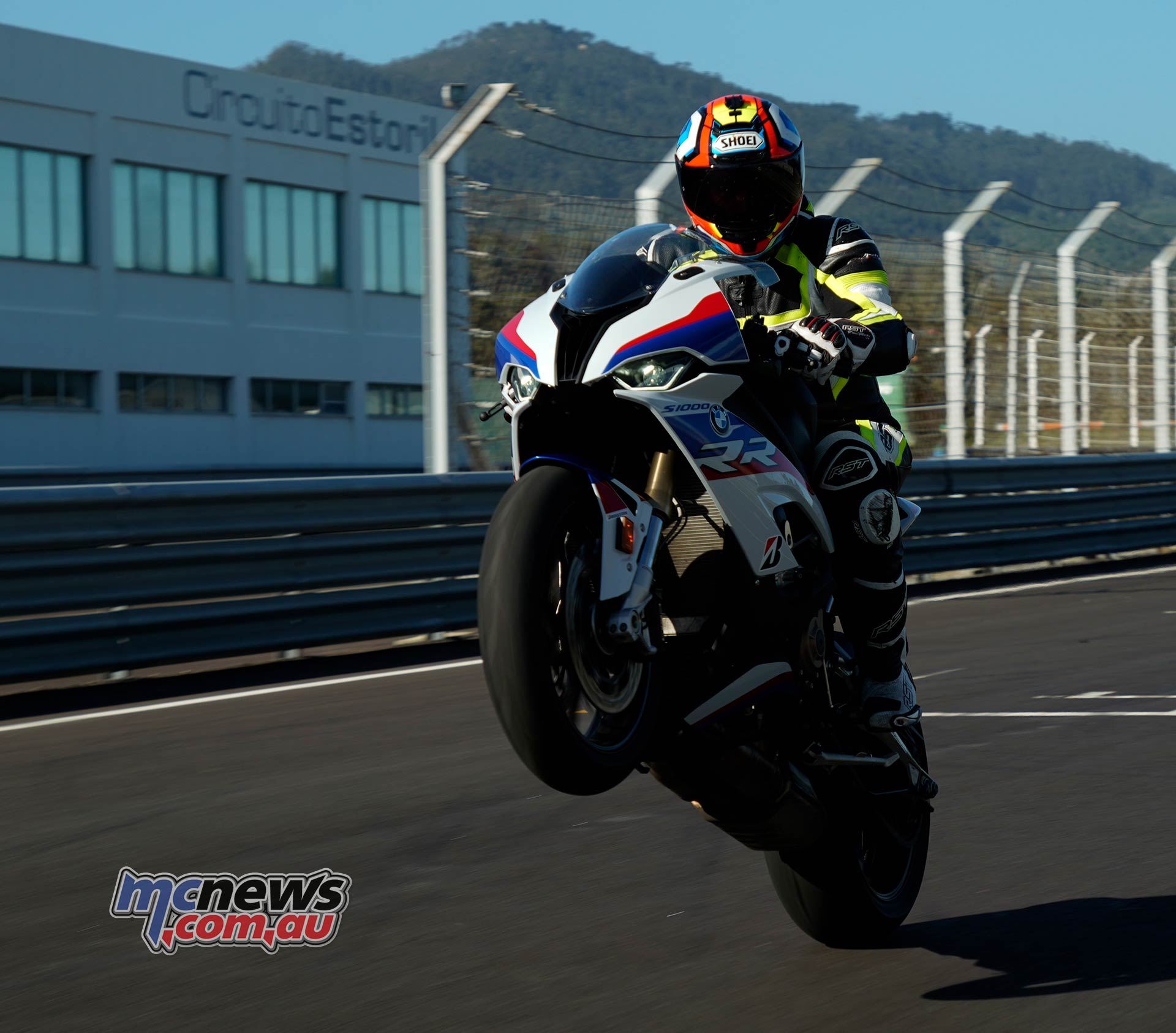
We got four sessions on track with session one a great introduction run. Jurgen Fuchs (BMW test pilot) lead us for a seven-lap run around the Estoril circuit which was a great way to show us the lines and find our way around.
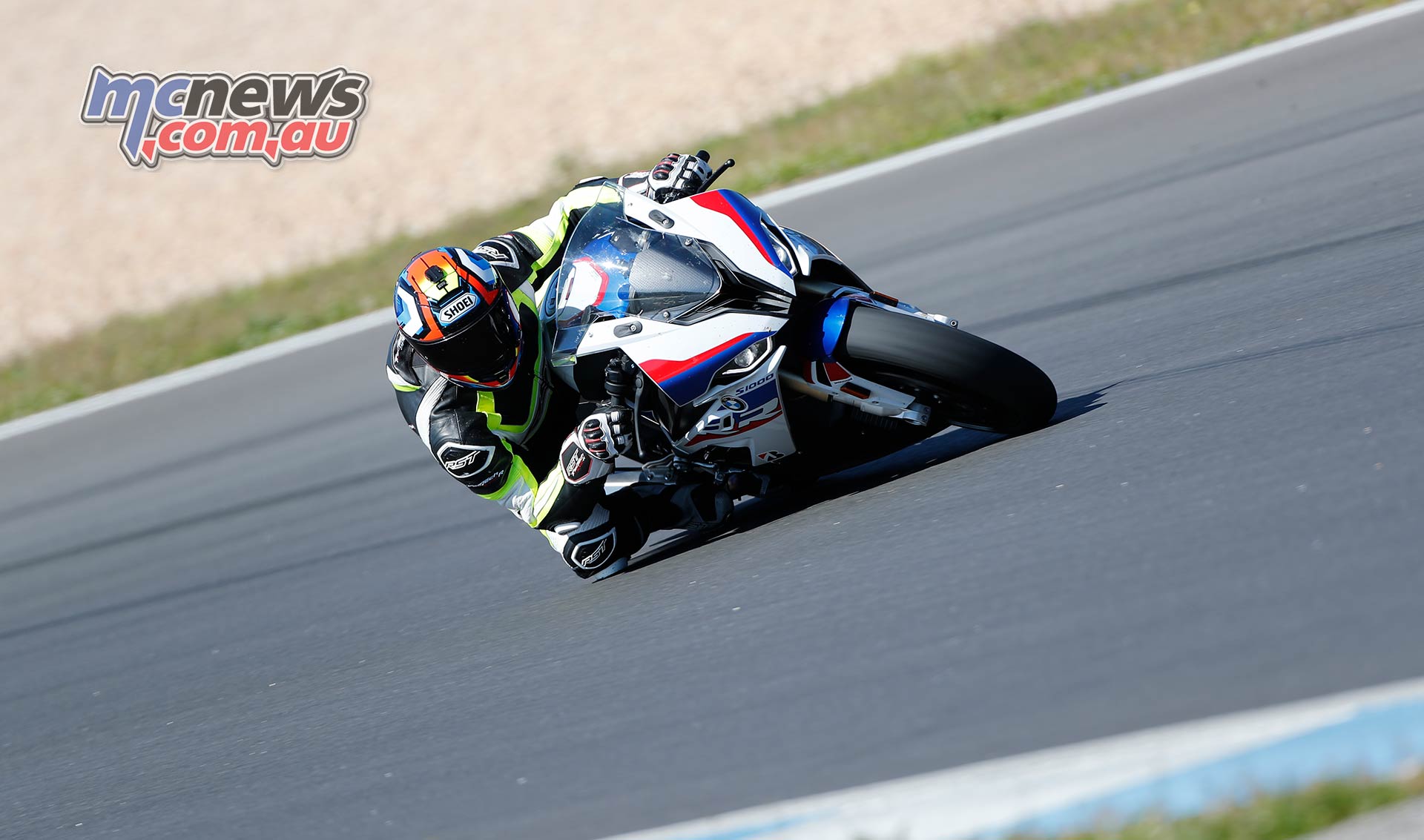
The comprehensive electronics system was on a pre-set Race Pro 1 map which erred on the safe side with plenty of intervention giving me a safe feeling.
The traction control set on positive three took control of the bikes power and kept things calm and muted. We had to follow Jurgen but the first impressions were good. The engine is ultra-smooth, and the extra torque was apparent, especially at learning track mode speed.
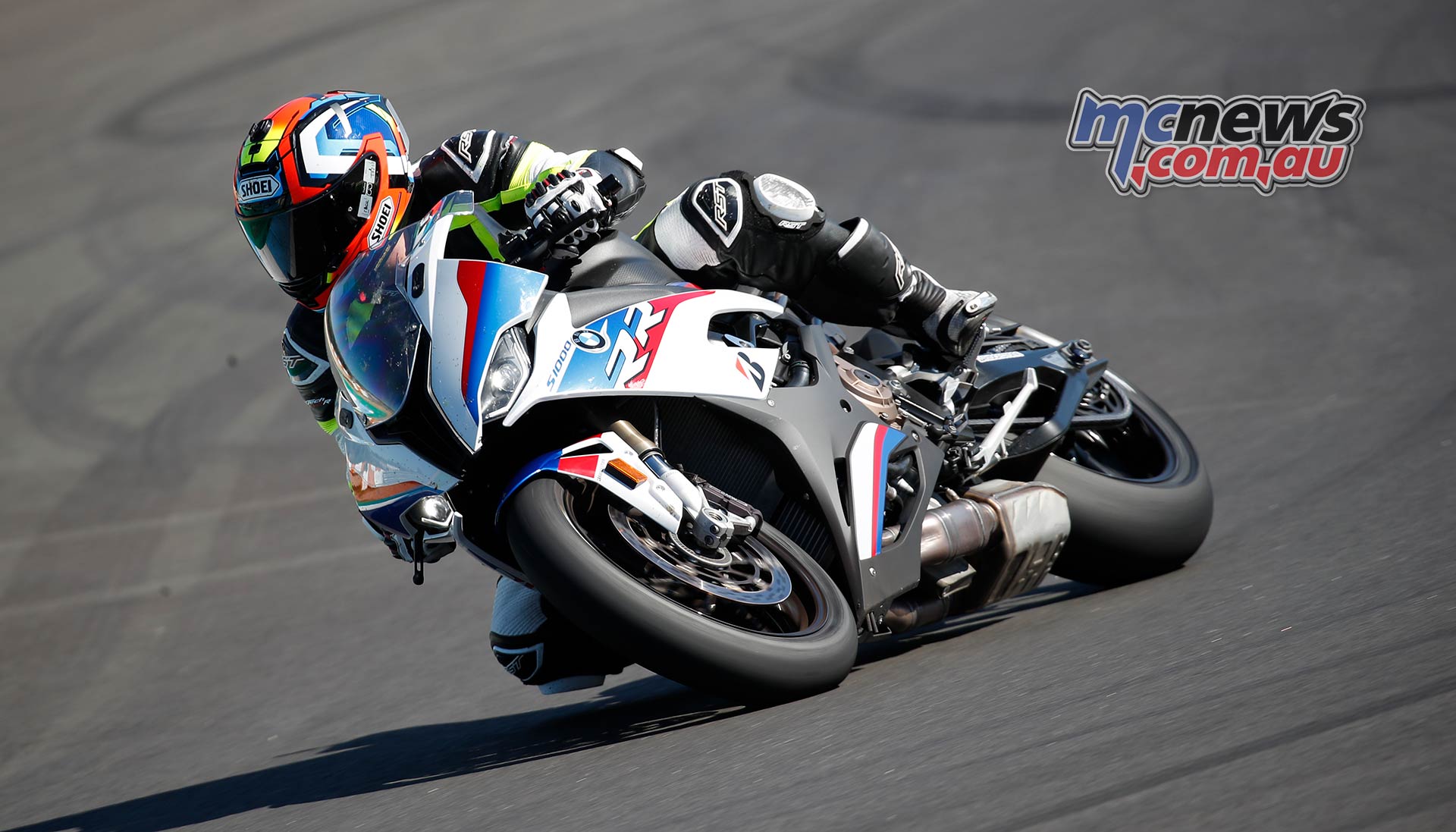
The throttle connection was perfect and there was no discernible feeling or glitch at around that magic 9000 rpm cam changing point. We were on the standard Bridgestone S21 tyres for this part of the day, and they were unfortunately the weak point of the bike.
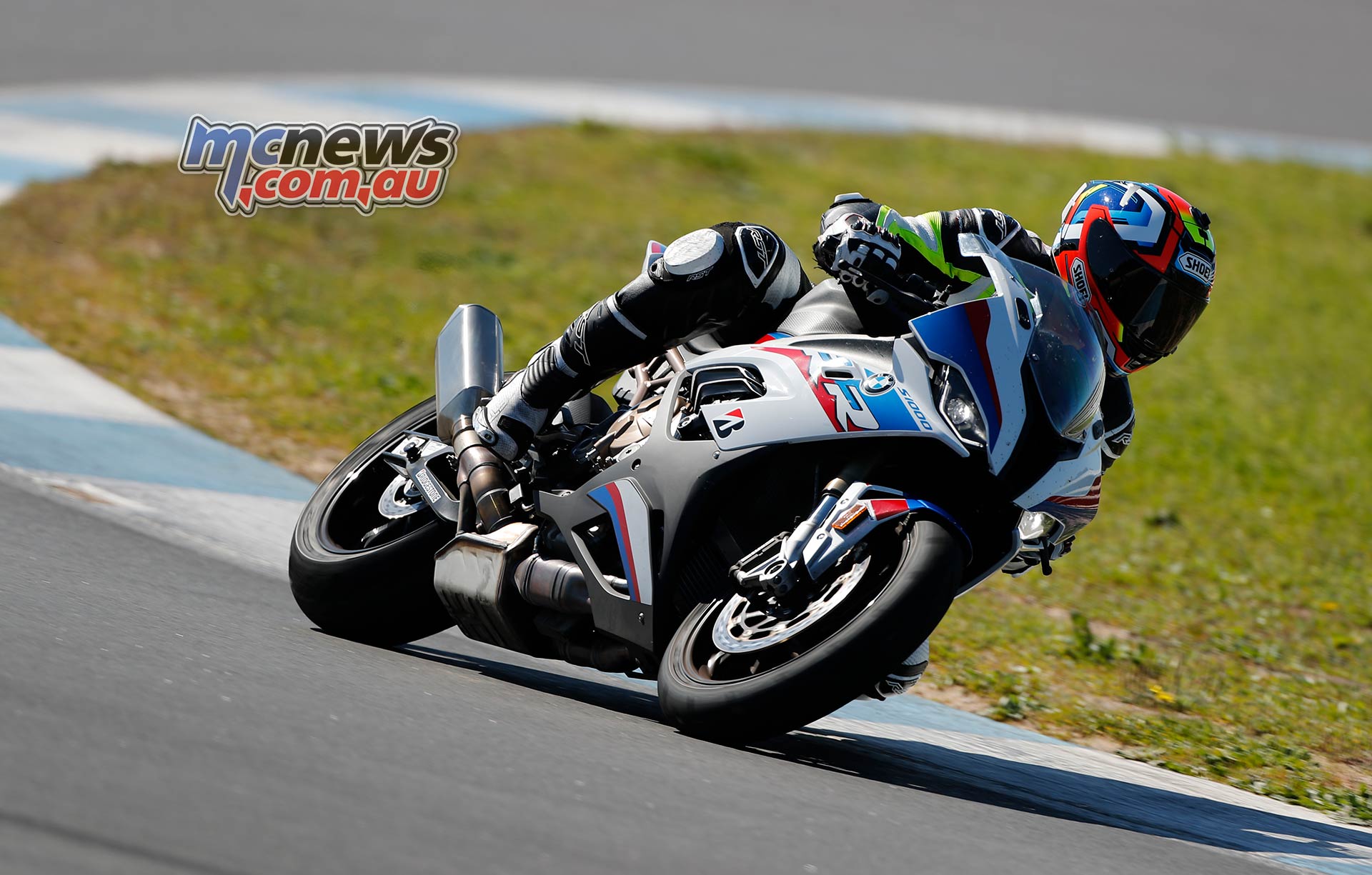
Being a 10 percent track tyre and more of a sports-touring tyre, I was unable to really get much feedback from the bike. What I could feel though was just how natural and neutral the bike felt, from an initial point of view.
The other positive was with the level of wheel-spin we were getting, I was able to give the traction system a good work out. As expected it worked extremely well and caught every near high-side moment I had, and I had a few…
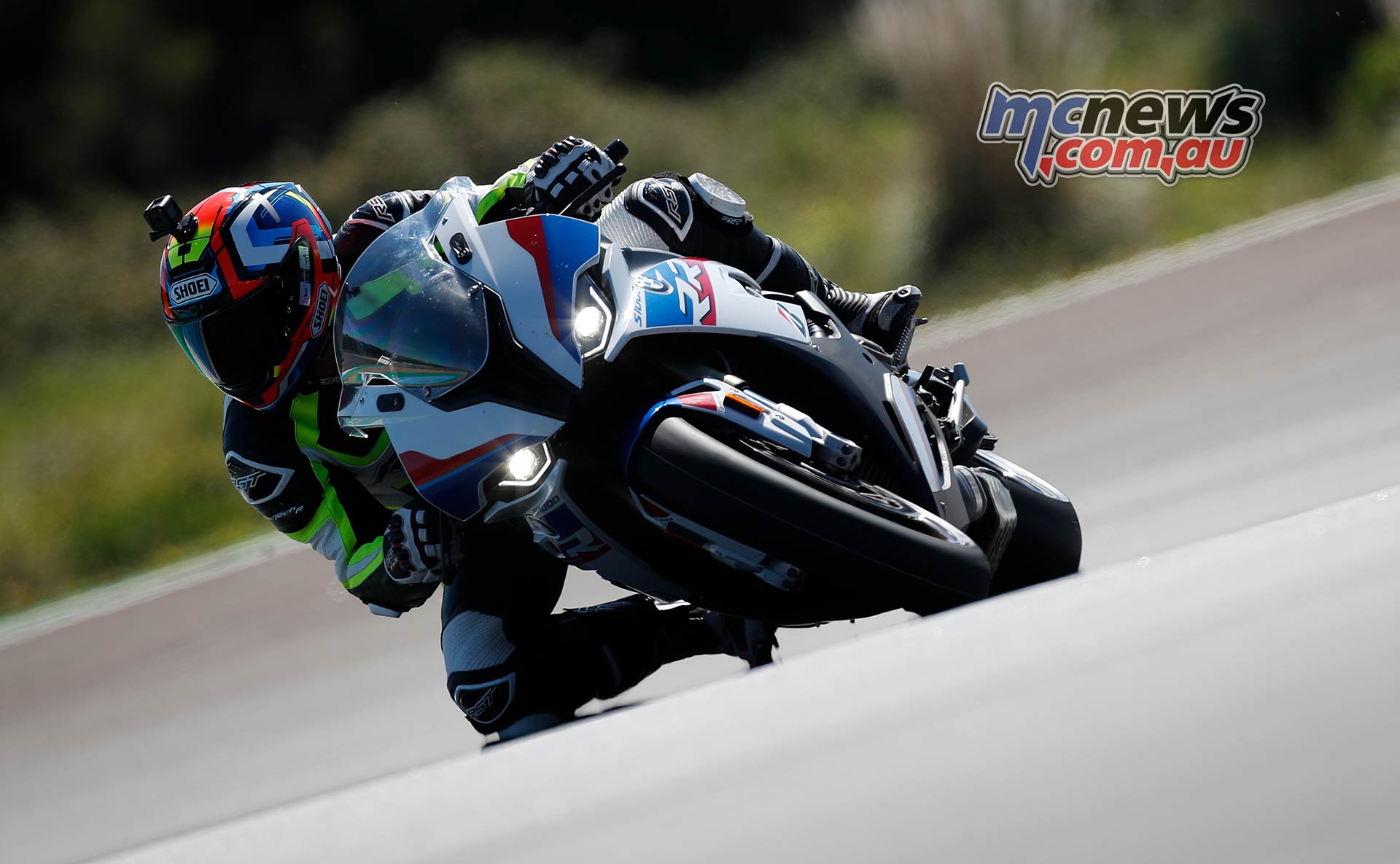
Even with the OEM tyres the RR turned on a dime and made the apex every time. There was no excuse for not liking the set up or the way it felt because if you didn’t like the way it went into a corner, you could just change it with a few tweaks on the dash.
After another session some Bridgestone soft production slicks were fitted and my face of desperation turned to one of joy. Oh my, how a little bit of grip can change things. Literally the bike was on rails with the change of tyres, and pushing closer to the limits became enjoyable.
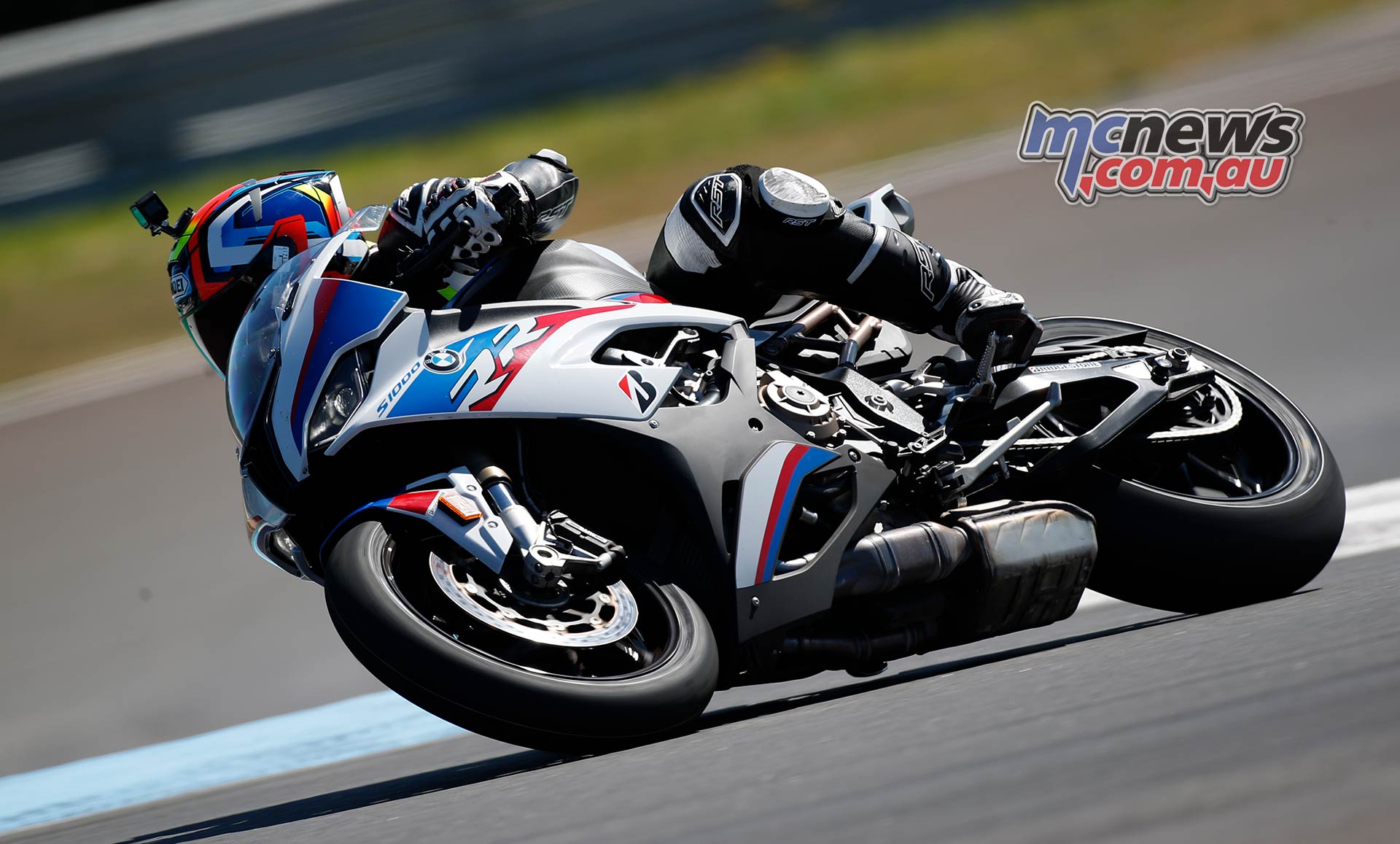
I was hitting close to an indicated 299 km/h down the main straight in Estoril and loving it. The standard front brakes were certainly getting a work out and there was some fade, I guess not many people will be decelerating the stock bike again and again from 300 without race pads all that often…
The feel from the brakes was quite good though, with progression and lever feel letting me brake right to the mid-point of the turn, like I would on a superbike.
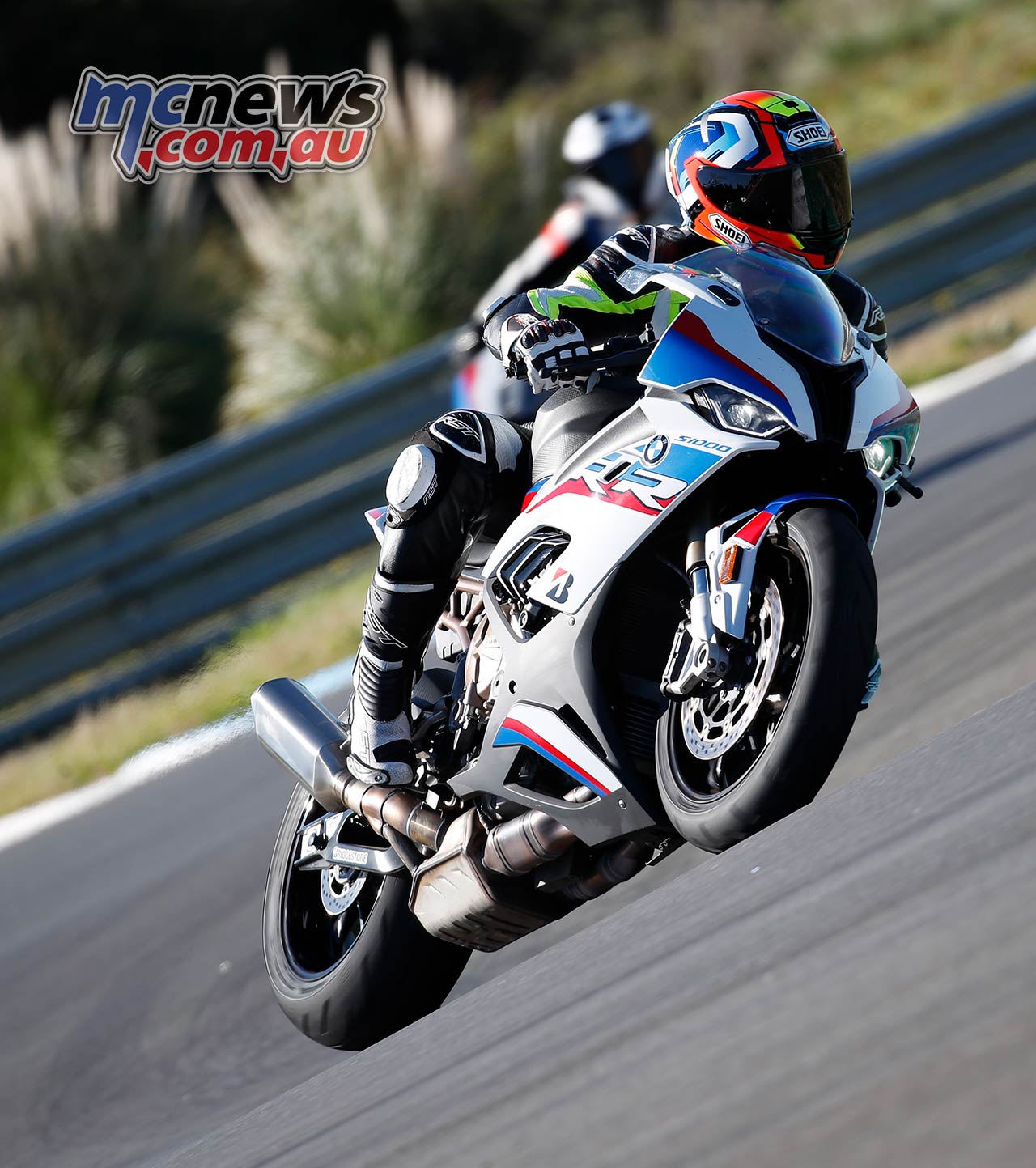
There’s a tight chicane about half way round the circuit, with a quick change of direction at slow speed that would have a lot of bikes feeling a little uncomfortable, but once again the Beemer was a cinch to ride and made it easy to take the line I wanted. It went through the change of direction with complete stability. This was the M package bike with those sexy carbon rims though, and they no doubt played their part with the agility of the package.
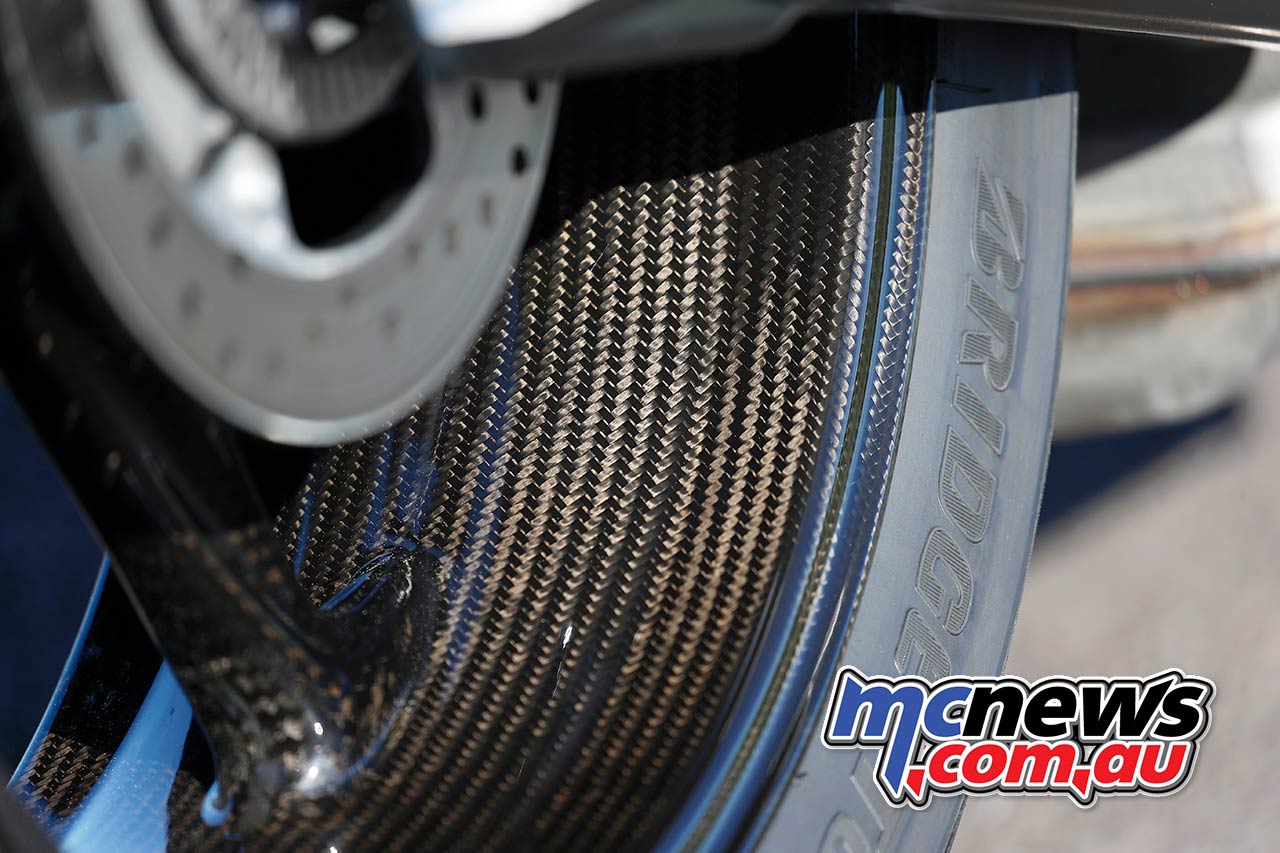
The new rear end has a different layout to the old bike and a different link ratio that lets a relatively soft 6.5 kg spring be used. With the Bridgestone rear slick, I didn’t have any problem at all, no slides, no spinning and it was very stable. I would have liked to try it with a Pirelli slick, one I know well, to see what happened when it did let go, but that will have to wait until next time.
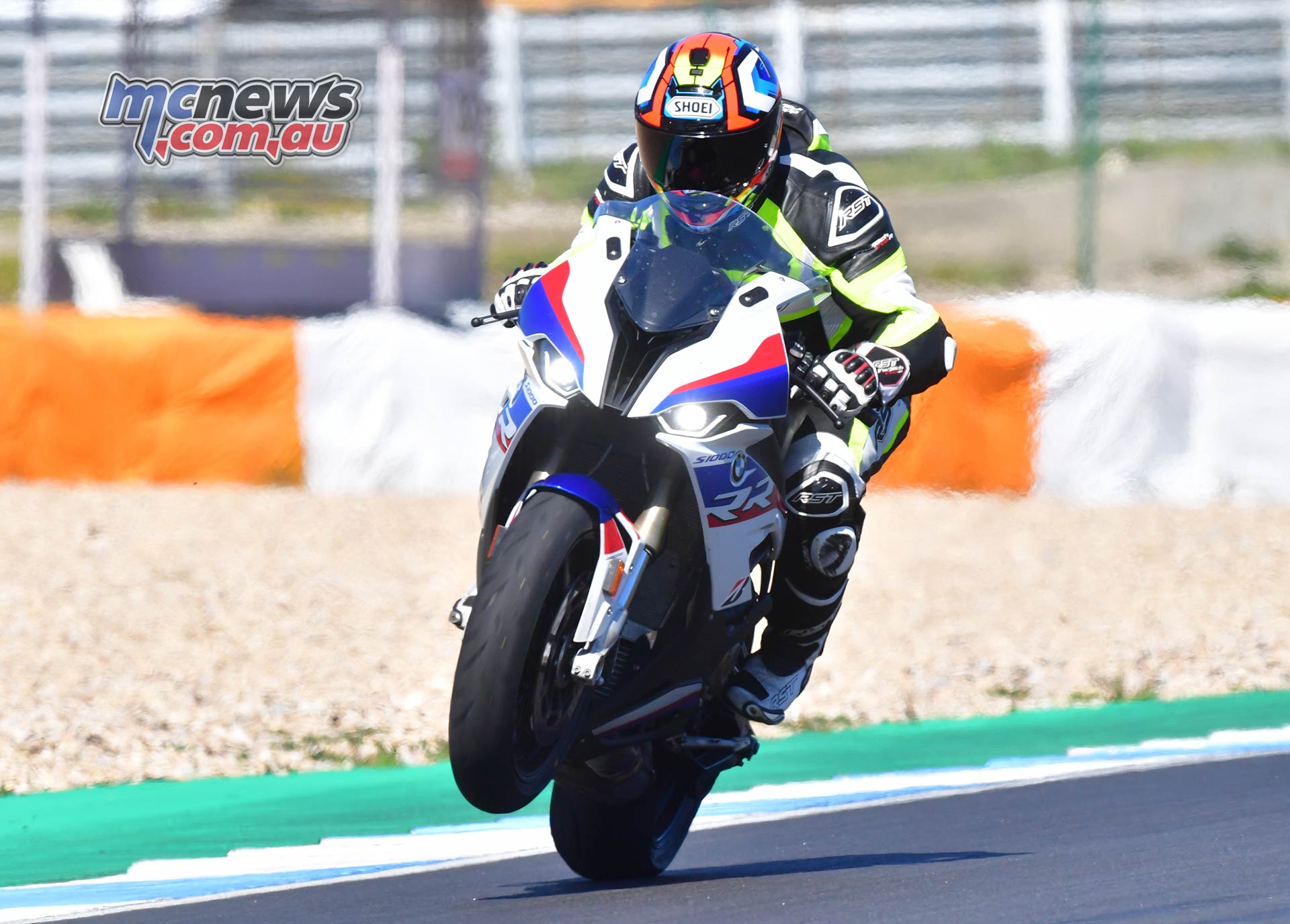
It was a little soft in the front for very hard brakers, but a switch to the Pro 3 map, and some stiffer compression settings helped a bit. There was scope to put pre-load on the front, and I would have done that next, but time didn’t really allow for it. The chassis was very good, and an improvement in turning over the old bike was obvious.
I found that I didn’t have to worry about what the bike was doing when I was riding, just enjoy my riding and focus on my lines, and that is the sign of a good bike. Its stability is excellent, and the suspensions more conventional shim stack system was a definite improvement, especially if you plan on hitting the track.
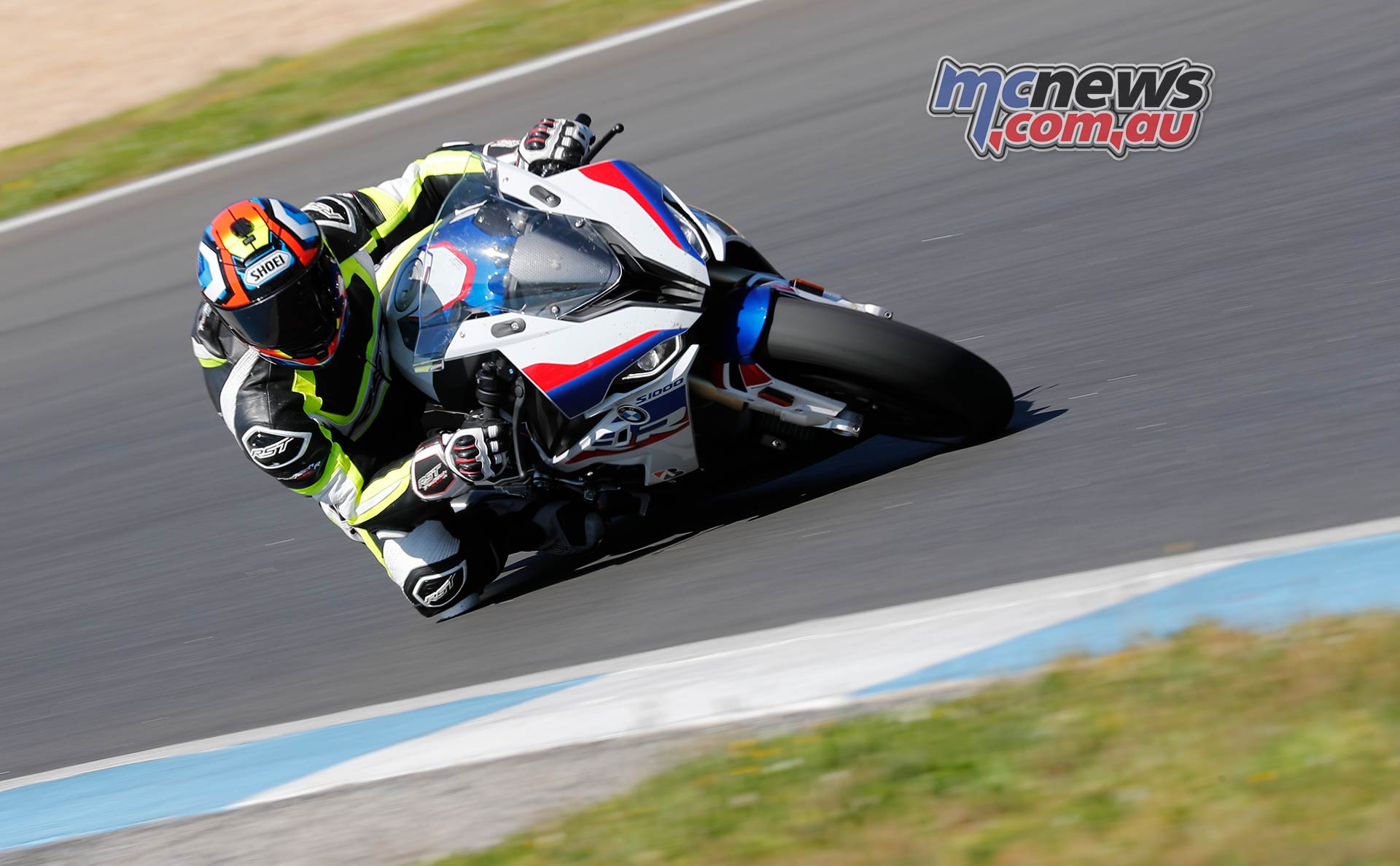
The engine feels fast, and with the extra torque I found I could use a higher gear than normally one would think. I didn’t get the chance to ride it on the road at all, but if you like riding through the hills and on the track, this new RR will no doubt be a great choice.
Video
Steve Martin and the BMW S 1000 RR
At the end of the day the new RR is good, we all knew it was going to be from the start. It’s got all the right DNA to be a great road bike, through to a WSBK winner once sorted in race trim. It is also comfortable and user friendly with all the gizmos ever invented, and then some.
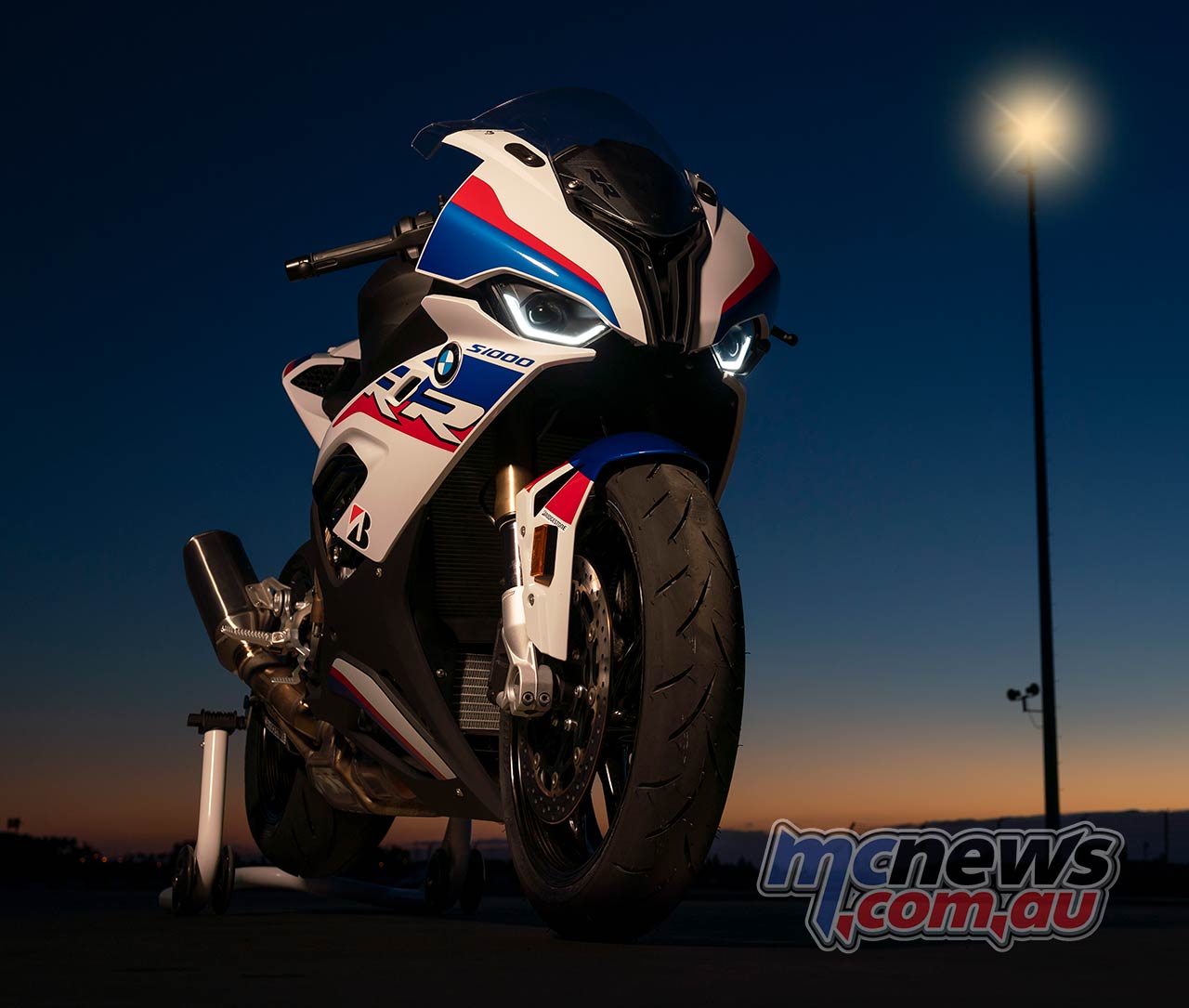
The S 1000 RR is a bike made to dominate the road going superbike scene for the next ten years, sort of like they did with the K46. Can it win a world championship in the future? Well that’s just a matter of money, but the answer is probably yes.
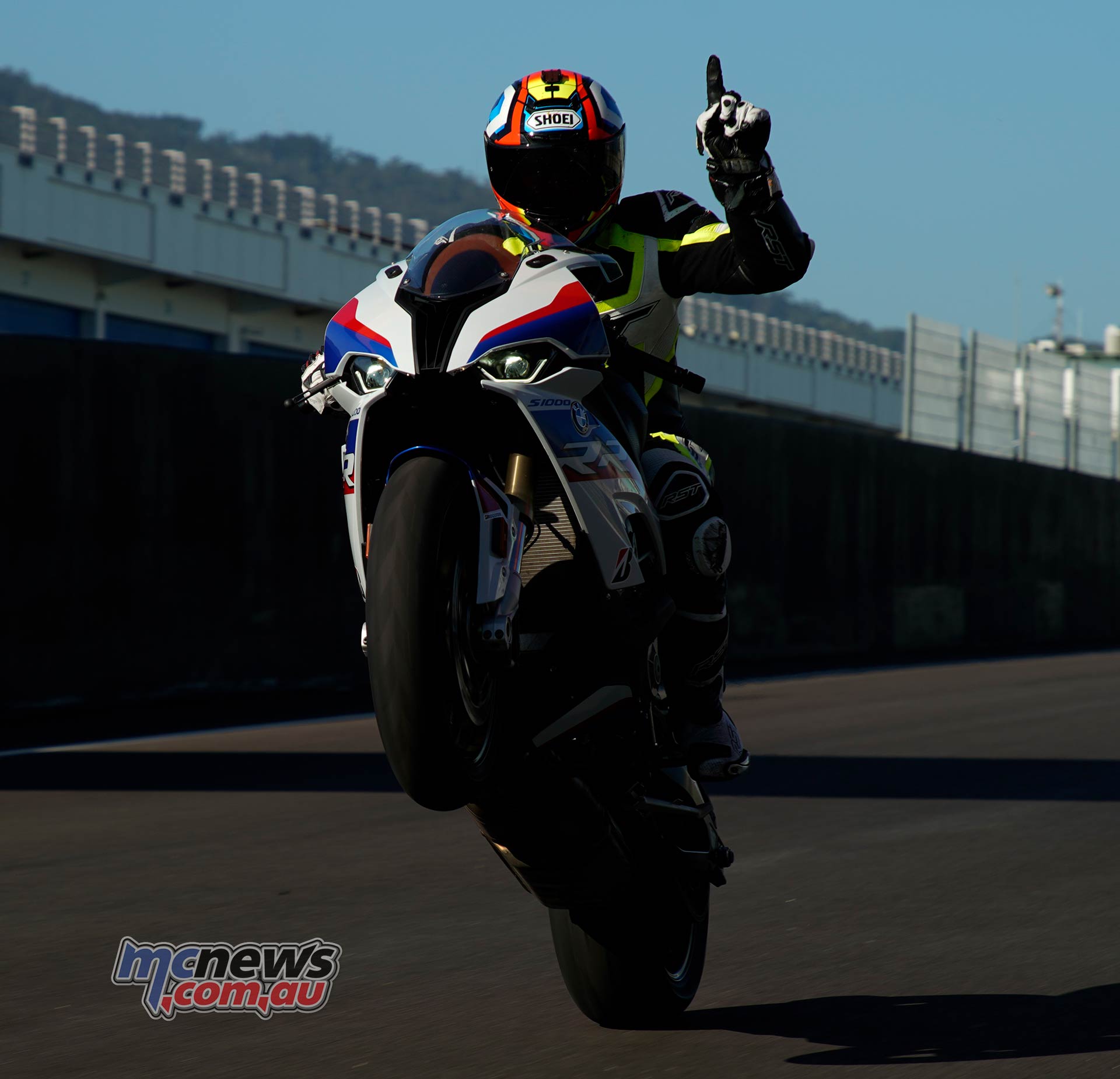
| 2019 BMW S 1000 RR Specifications | |
| Engine | |
| Capacity | 999 |
| Bore/stroke | 80/49.7 |
| Output | 152/207 |
| at engine speed | 13,500 |
| Torque | 113 |
| at engine speed | 10,500 |
| Type | Water-cooled in-line 4-cylinder engine |
| Compression/fuel | 13.3:1 / RON 95+ (knock control; rated output with 98 RON) |
| Valvetrain | 16-valve, DOHC, ShiftCam Variable, 33.5mm in, 27.2mm ex |
| Throttle Bodies | 48 |
| Engine control | BMS-O |
| Alternator | 450 |
| Headlamp | LED low beam twin headlamp in free-form technology |
| LED high beam free-form surface/modular design | |
| Power transmission – gearbox | |
| Clutch | Multi-plate anti-hop wet clutch, mechanical |
| Gearbox | Constant mesh 6-speed gearbox |
| Primary ratio | -1.652 |
| Transmission ratios | -2.647 |
| 2.091 | |
| 1.727 | |
| 1.500 | |
| -1.360 | |
| 1.261 | |
| Rear wheel drive | Chain |
| Secondary ratio | -2.647 |
| Suspension | |
| Frame | Aluminium composite bridge, self-supporting engine |
| Front Suspension | 45mm USD forks, slide tube diameter, fully-adjustable, 120mm travel, DDC |
| Rear Suspension | Aluminium underslung swing-arm with central spring strut, fully-adjustable, 117mm travel, DDC |
| Wheel castor mm | 93.9 |
| Wheelbase mm | 1441 |
| Steering head angle ° | 66.9 |
| BMW S 1000 RR | ||
| Brakes | Front | Twin 320mm disc, radial 4-piston fixed calipers |
| Rear | Single 220 mm, single-piston floating caliper | |
| ABS | BMW Motorrad ABS Pro (part integral, disengageable) | |
| Traction control | BMW Motorrad DTC | |
| Wheels | Standard: Die-cast aluminium wheels | |
| Forged aluminium wheels as part of Race Package option | ||
| Carbon fibre wheels as part of M Package option | ||
| Tyres | Front | 3.50 x 17″ |
| Rear | 6.00 x 17″ | |
| Front | 120/70 ZR17 | |
| Rear | 190/55 ZR17 | |
| Dimensions and weights | ||
| Total length | mm | 2073 |
| Total width with mirrors | mm | 846 |
| Seat height | mm | 824 |
| kg | Standard: 197 | |
| Fuelled | with Race Package option 195.4, | |
| with M Package option 193.5 | ||
| Permitted total weight | kg | 407 |
| Fuel tank capacity | L | 16.5 |
| Performance figures | ||
| Fuel consumption (WMTC) | l/100 km | 6.4 |
| CO2 | g/km | 149 |
| Acceleration | 0-100 km/h | 3.1 |
| Top speed | km/h | 200 |
